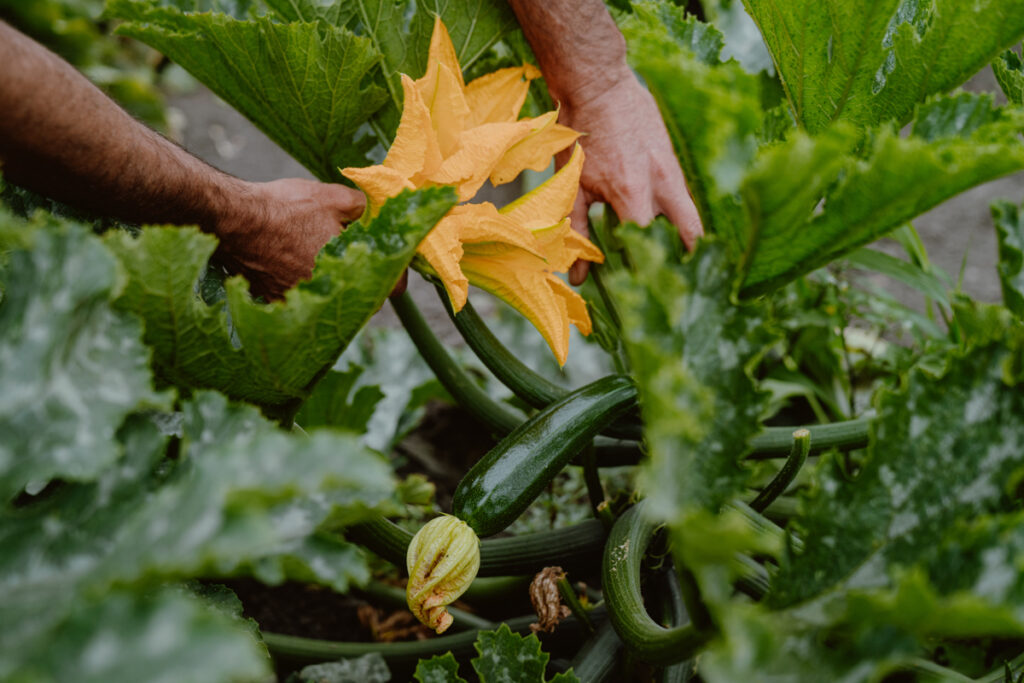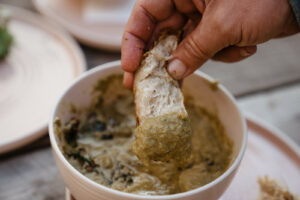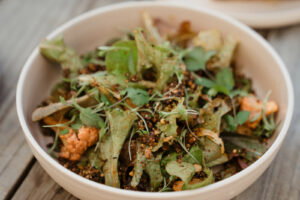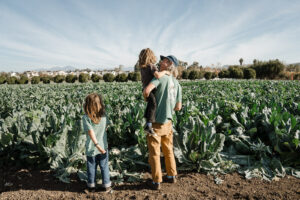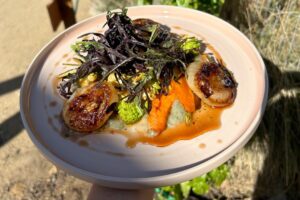Welcome to the Summer Harvest Guide, a comprehensive guide to every fruit and vegetable we grow on the farm throughout the season. Summer is an abundant time on the farm with Summer Squash blanketing our fields — providing protection to the soil and nourishment for the community. In this Harvest Guide, you’ll find a short history of how the vegetable or fruit transformed from its wild origins to the beautiful, flavorful version you see today, best storage practices, notes about the item’s nutrition and flavor profile, as well as cooking and preparation best practices.
Alliums
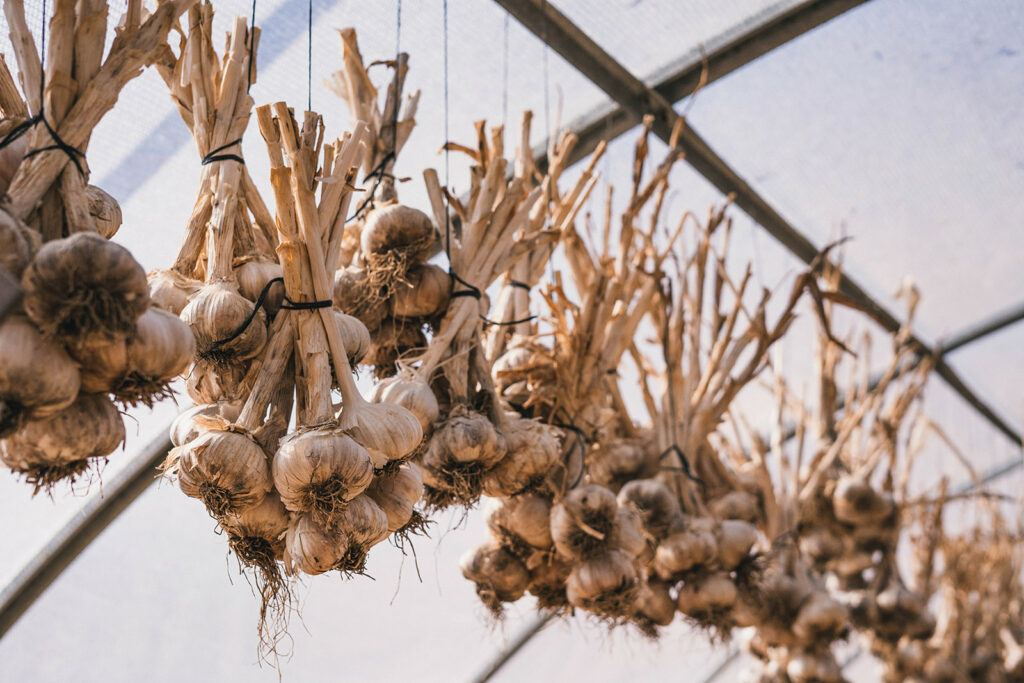
One of the world’s oldest food sources, vegetables in the allium family include all varieties of onions, as well as garlic, leeks, and chives.
SEASONAL IN SOUTHERN CALIFORNIA
PLANT: September through June
HARVEST: January through December
HISTORY
Believed to be a staple of the prehistoric diet, alliums likely originated in the region between central Asia and the Middle East; mysteriously, some varieties are native to North America, as well. Easy to grow, transport, preserve and store, alliums were not only a staple of ancient diets but also a symbol of longevity and the afterlife. Their antimicrobial, antifungal, stimulant and diuretic properties also made alliums useful in early medicine—they are mentioned in texts from Egypt, Greece, India and China as a curative for impotence, scorpion bites, heart disease, lack of energy, and the Black Plague. Spread throughout the Western world by both conquerors and traders, leeks were carried to North America by English settlers, and garlic followed during later waves of European immigration.
PREPARATION
All varieties of alliums come into their own when slowly cooked over low heat, which allows their sugars to caramelize and their fibers to break down. The lighter flavor of shallots and leeks pair well with poultry, pork, eggs, and dairy, while the heavier flavors of onions and garlic complement rich and hearty dishes. Small varieties such as Cipollini and Torpedo onions are delicious when roasted, glazed in balsamic or sherry vinegar, and sprinkled with herbs such as thyme or rosemary. Chopped chives are a bright and piquant garnish for soups, dips, potatoes, egg dishes, fish and other seafood.
COOKING
Finely chop shallots and/or leeks and cook slowly in plenty of olive oil over medium heat, until they are fragrant, broken down, and deep golden-brown in color. Add salt, pepper, and a splash of sherry vinegar, and keep cooking over low heat until liquid has thickened. Toast several slices of crusty bread and spread with goat cheese or ricotta. Spoon shallot/leek mixture over the cheese spread, top with fresh, ripe tomato slices, and sprinkle with chopped chives and, if desired, a pinch of grated lemon zest.
PRO TIPS
If serving alliums raw, soak slices in hot water to mellow their pungency.
Arugula
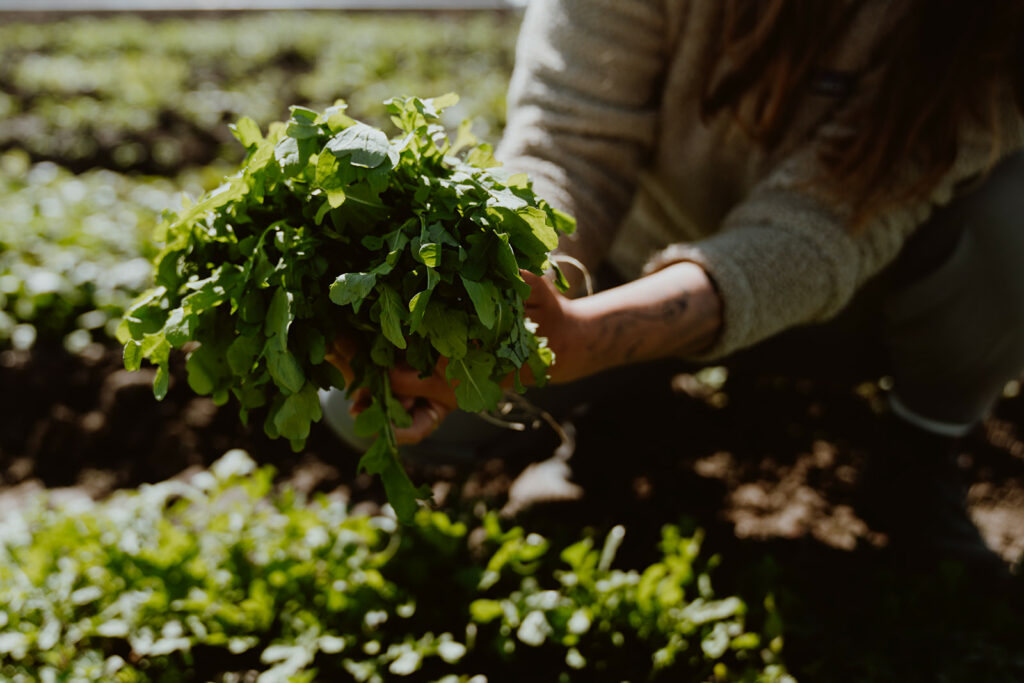
This wild leafy green, also known as “rocket,” was used in Mediterranean kitchens for centuries, yet was relatively unknown to American eaters until the 1990s. As part of the mustard family, it has a peppery bite with both sweet and bitter undertones. This complex flavor, along with the green’s versatility, made arugula an instant hit for home cooks and professional chefs.
SEASONAL IN SOUTHERN CALIFORNIA
PLANT: January through December
HARVEST: January through December
HISTORY
For thousands of years, arugula was widely used for both culinary and medicinal purposes. Along with being used as an anesthetic and as an aphrodisiac, arugula was eaten on a daily basis in Italy and featured in traditional recipes from France to the Middle East. For Jewish groups around the Mediterranean region, arugula was the standard bitter green on Passover plates.
NUTRITION
Arugula is an excellent source of vitamins A, B6, C, and K, as well as folate, calcium, iron, magnesium, phosphorus, potassium, and manganese. Its high nutritional content is linked to diabetes management, cancer and osteoporosis prevention, and cardiovascular health, as well as improving vision, digestion, and immune response.
STORAGE
After rinsing arugula leaves thoroughly, spread on towels or spin until very dry, then pack loosely in a plastic bag with a layer of paper towels to absorb moisture. Arugula will stay fresh in the refrigerator for about a week.
PREPARATION
Arugula is a truly versatile vegetable that can be eaten as a salad green, sauteed like collards or kale, and even used as an herb. While the classic method of serving is with fresh mozzarella and ripe tomatoes, arugula leaves can also be tossed into any stir-fry just before serving, added to pizzas or sandwiches, or substituted for basil in an extra-spicy pesto.
COOKING
Combine arugula with warm roasted or grilled broccoli—toss until arugula is wilted. top with pine nuts, raisins, and shaved Parmesan cheese, and drizzle with a warm dressing of olive oil, lemon juice, and anchovy paste.
PRO TIPS
Younger arugula balances its peppery flavor with a sweeter taste, while more mature leaves have a bitterness similar to dandelion greens.
Basil
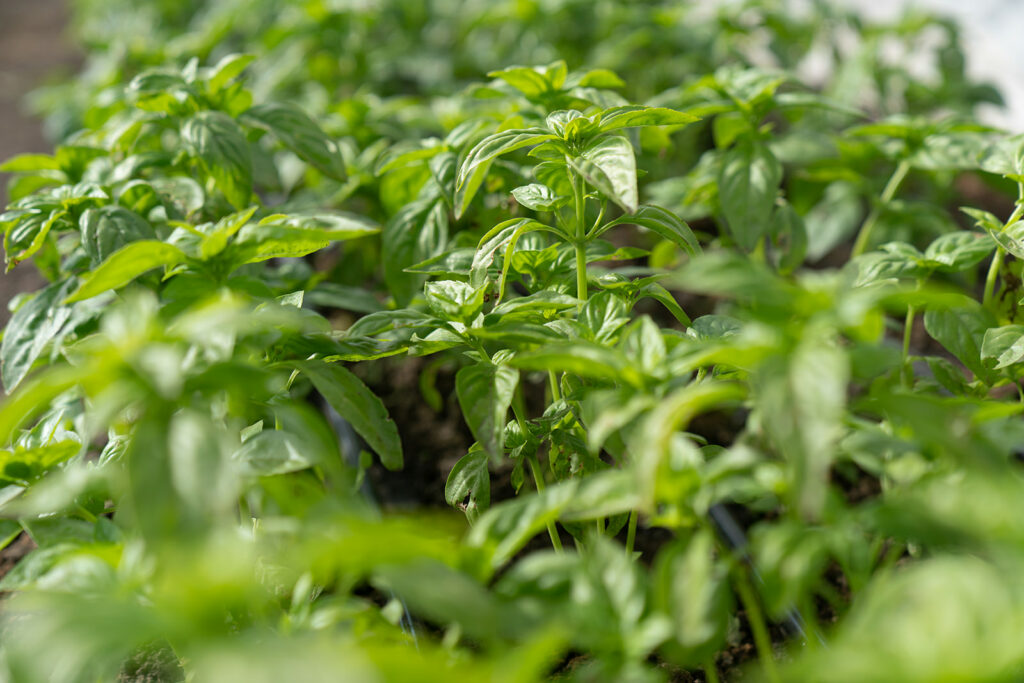
Basil is a member of the mint family, believed to have originated in India or possibly China. Its adaptability to being grown indoors allowed basil to spread throughout the world and be adapted to a vast array of cultural cuisines.
SEASONAL IN SOUTHERN CALIFORNIA
PLANT: March through August
HARVEST: June through October
HISTORY
Cultivated for at least 5,000 years, basil was a primary ingredient for embalming in ancient Egypt and is included in many ancient medicinal traditions such as Ayurveda. In Jewish tradition, basil was consumed during religious fasts to bolster strength, while certain African cultures used basil as protection against scorpion stings and snakebites. Shared along trade routes throughout Europe, the Middle East, and Southeast Asia, basil has been incorporated into many diverse foodways, and at least a dozen culinary subspecies are known today.
NUTRITION
Basil is a good source of vitamin K, calcium, and several antioxidants that protect against skin aging and inflammation, and support cardiovascular and mental health.
STORAGE
Snip the bases of basil stems and place them in a jar with an inch or two of water at the bottom. Store at room temperature, out of direct sunlight, for up to 2 weeks.
PREPARATION
Most commonly used fresh in cooked recipes, basil can be added in the final stages of cooking pasta sauce, risotto, soup, or curry for a burst of spicy, citrusy flavor. Shredded fresh basil is a delicious condiment for summer vegetables such as tomatoes, eggplant, summer squash, and fresh corn. It pairs wonderfully with mild cheeses and can be infused into flavored oils. Classic pesto incorporates large amounts of fresh basil combined with toasted nuts, olive oil, and Parmesan cheese.
PRO TIPS
Cutting basil with a metal knife will quickly oxidize leaves. Either use immediately after cutting, or tear basil leaves by hand.
Beets

Known for their intense color and earthy taste, beets are one of the oldest vegetables in cultivation. Believed to have evolved from a prehistoric North African root vegetable, the beet features in cuisines around the world throughout history, from ancient Greece to Elizabethan England to the early years of American independence.
SEASONAL IN SOUTHERN CALIFORNIA
PLANT: September through June
HARVEST: June through October
HISTORY
Beets were so highly prized in the ancient world that early farmers developed methods for growing them all season long. Surprisingly, only the greens were widely consumed—the root was used only medicinally. Growers began cultivating beets for their roots in the 16th century, but they did not become widely popular until the 1700s when scientists and cooks discovered their use as a sweetener.
NUTRITION
Beets are rich in vitamin C, folic acid, and minerals such as potassium, manganese, and iron. They also contain betalains, a unique cancer-fighting antioxidant, and are associated with improved blood flow, lower blood pressure, and increased exercise performance.
STORAGE
Separate green tops, pat unpeeled beets dry, and store in a ventilated bag in the vegetable crisper draw for up to 2 months. Beet greens can be wrapped in a damp paper towel and stored in the refrigerator for up to 2 weeks.
PREPARATION
Today, beets are prepared in just about every way imaginable, from grated raw to pickled to roasted, steamed, baked, fried, and even used as a food coloring. Their minerally flavor pairs wonderfully with tangy flavors such as goat cheese, tahini, or sour cream, and adds a burst of earthy sweetness when served with milder root vegetables such as turnips and potatoes.
COOKING
Peel beets, cut into cubes, toss with olive oil and salt, and roast at 375 degrees until tender enough to pierce with a fork. Remove and drizzle with tahini that has been thinned with water and a splash of lemon juice. Sprinkle with sauteed garlic, toasted pine nuts, and feta cheese.
PRO TIPS
There’s a reason beets are popular as a natural dye—their intense color will stain anything it touches. Handle raw beets using latex gloves, and cover your cutting surface with a paper towel or old dish cloth to avoid stains.
Carrots
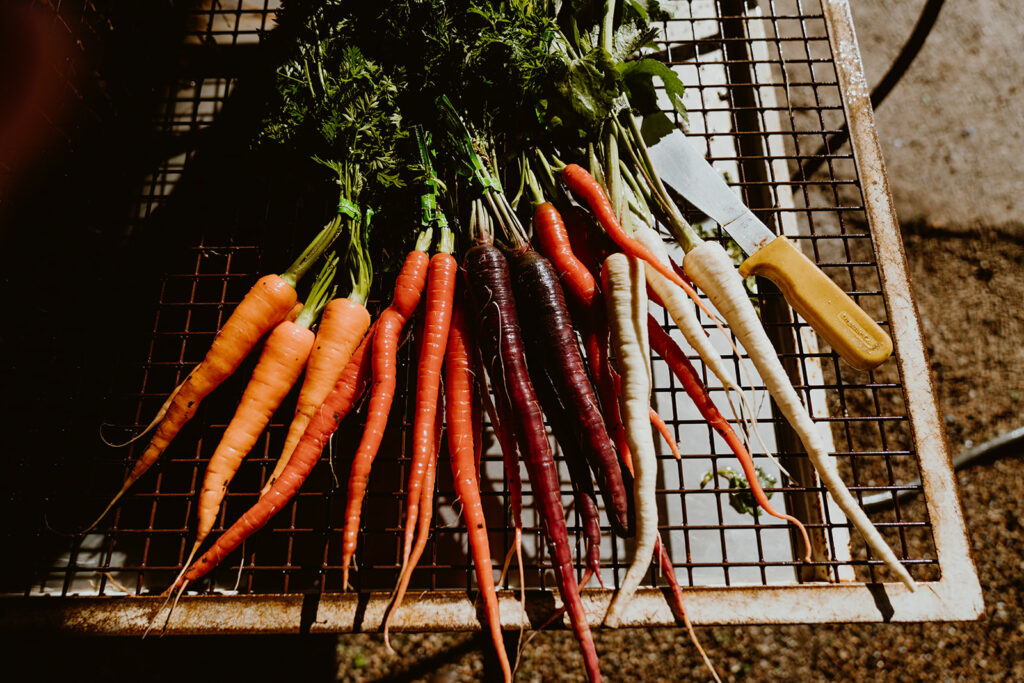
Perhaps the most recognizable vegetable in the world, carrots are known for their kid-friendly sweetness and crunchy texture. While it is prized today for its bright orange root, carrot leaves and seeds offer an herbaceous flavor similar to its related plants such as dill and parsley.
SEASONAL IN SOUTHERN CALIFORNIA
PLANT: September through June
HARVEST: January through December
HISTORY
Domesticated from a wild plant native to Persia, carrots were originally grown for their leaves and seeds. Over time, the plant was selectively bred for a larger taproot, which became popular in the kitchens of ancient Rome and early Europe. Each century spread the carrot farther around the globe, from the Mediterranean and the Middle East to India and China. The orange carrot is fairly new, in terms of the vegetable’s history.
NUTRITION
The bright orange color of carrots comes from a high concentration of beta-carotene, an antioxidant that the human body processes into Vitamin A. Carrots are also rich in vitamin K1, potassium, and fiber.
STORAGE
Snip off leaves about ¼ inch from the top of the carrots, clean off any soil, wrap in a damp cloth or paper towel, and store in an unsealed bag or container in a refrigerator crisper for up to 2 weeks. Avoid cutting the daikon before storing, as the potent smell will spread throughout your refrigerator. Well-dried leaves can be stored for up to a week.
PREPARATION
The bright colors and sweet flavor of carrots have made them a popular choice for every preparation you can imagine. An essential for crudite plates, raw carrots can also be grated, sliced, pickled, and juiced. Their firm texture stands up well to roasting, stewing, frying, or dehydrating. When steamed and mashed, they have a pulpy texture that makes for perfect baby food and is easy to add to baked goods.
COOKING
Peel carrots and chop into bite-size pieces, then add to a large saucepan and cover with water. Simmer until carrots are fork-tender. Add two spoonfuls of butter and two spoonfuls of sugar or another sweetener, along with salt, pepper, and a savory spice mix like vadouvan or garam masala. Cook on low heat, stirring occasionally, until the liquid has thickened into a glaze. Top with finely chopped carrot tops or other herbs, and serve warm.
PRO TIPS
Don’t discard carrot tops. Put cut carrots tops into rice to add color and texture. Upcycle the carrot tops by making a homemade pesto.
Celery
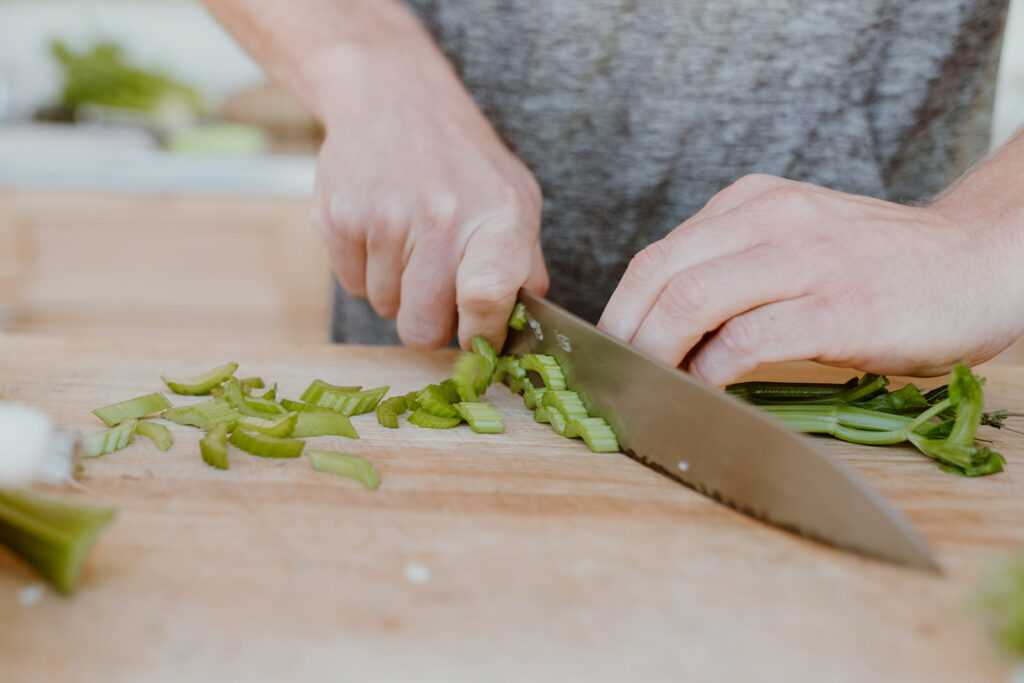
Celery (Apium graveolens) is a marshland plant that has been cultivated as a versatile vegetable with a high fiber content. Depending on location and cultivar, either its stalks, leaves or hypocotyl are eaten and used in cooking. All parts and cultivars of celery are highly nutritious, easy to use in culinary creations, and absorb flavor well.
SEASONAL IN SOUTHERN CALIFORNIA
PLANT: March through November
HARVEST: August through December
HISTORY
Celery is native to the Middle East and Mediterranean areas. Its various traditional and ancient uses include flavoring for Greeks and Romans, medicine in ancient China, and food in France. The modern day version of celery that we are all familiar with was developed in the late 18th century, with fleshy stalks and parsley-like leaves.
NUTRITION
Celery is incredibly rich in fiber, and contains high amounts of antioxidants, flavonoids, and vitamin C. Celery is rich in a phytochemical known as phthalides, a compound known to lead to lower blood pressure. Celeriac, a variety of celery cultivated for its edible root-like stem and shoots, also has a robust nutritional profile. These nutrients include fiber, vitamins B6, C and K, antioxidants, and important minerals. Cutting celery, another cultivar grown for its thinner stalks and leaves, is used medicinally in Ayurveda (ancient Indian healing practice) and is anti-inflammatory.
STORAGE
Wrap a whole, uncut celery in aluminum foil in the crisper drawer of your refrigerator for up to four weeks. Don’t wash or cut until ready to use. To store cut celery stalks, place in a container and submerge with water with a lid for up to two weeks. Replenish the water every couple of days. To store cutting celery, place in a jar with clean water and store in a cool place for up to a week. Celeriac will last several weeks in the fridge, and can also be chopped up and frozen to preserve.
PREPARATION
Celery stalks are incredibly versatile and can be eaten raw or cooked. Common methods of eating raw celery include crudite dishes with dip, chopped up in a salad, or freshly juiced. Popular cooking methods of celery stalks include braising, boiling, stir frying, sautéing, or adding to broths, soups, and stews. Common preparations of cutting celery include cooking in a vegetable stock, making pesto, garnishing with fresh leaves, or adding to a salad. Celeriac, or celery root, is best eaten peeled, sliced, and raw or cooked like any other root vegetable. Celery pairs well with blue cheese, butter, poultry, fish, and other vegetables.
COOKING
Prepare vegetables by washing, chopping, and peeling. Heat olive oil in a large saucepan over medium heat and add one chopped up brown onion. Cook onion until it’s softened, then add celery, celeriac, potato, and garlic. Cook and stir until lightly browned. Increase the heat, add vegetable or chicken stock of your choice, cover, and bring to a boil. Reduce the heat to low and simmer for for 30 minutes or until vegetables are softened. Remove the pan from heat and let cool for a few minutes. Process the soup either in a blender or with a handheld immersion blender in batches until smooth. Then return the soup to a pan over medium heat and stir in pure, grass fed cream. Season with salt and pepper and cook for 5 more minutes, stirring occasionally. Serve in a bowl topped with freshly chopped cutting celery leaves and/or parsley.
PRO TIPS
Celery stalks and celeriac both freeze well. Chop up and freeze on a baking pan for a few hours and transfer to bags to keep frozen for a few months. Blanch celery stalks to freeze for up to 6 months.
Chard
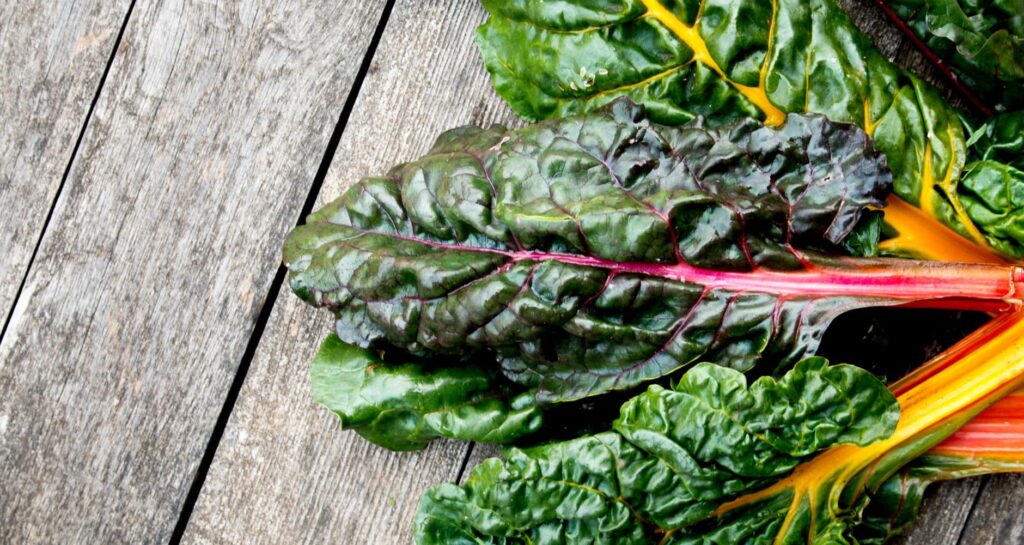
With its enormous spinach-like leaves and brilliantly colored stems, chard (also known as “Swiss chard”) is as beautiful on the table as it is nutritious. Chard pairs a spinach-like sweetness with a subtle salty bitterness and a hearty texture somewhere between spinach and collard greens. The best known cultivar of Chard, “Bright Lights,” was nearly lost during the 20th century, but is today beloved for its rainbow-colored stems.
SEASONAL IN SOUTHERN CALIFORNIA
PLANT: January through December
HARVEST: June through August
HISTORY
Closely related to beets, chard is believed to have originated in Sicily and was selectively bred for its large leaves. The word “chard” is a corruption of the French term carde, which refers to the thick thistle-like stem, while “Swiss” may refer to the Swiss botanist who classified the modern plant. Chard is almost exclusively grown in Europe until the 1830s, when it began to appear in gardens along America’s Eastern seaboard. By the end of the century, chard was commonplace across the country.
NUTRITION
Chard is rich in vitamins C, K, E, beta-carotene as well as manganese and zinc.
STORAGE
Wrap unwashed chard in a paper towel and store in a half-sealed bag in the refrigerator crisper for up to 7 days.
PREPARATION
Chard’s slightly briny flavor goes wonderfully with seafood and Asian flavors, while traditional French or Italian recipes will play well off its bitterness, and spicy curries benefit from its sweetness. Chard can easily be substituted for spinach in any recipe, and will not become as watery when cooked.
COOKING
Slice chard into ribbons and sauté with onions, garlic, and caraway seeds until soft. Stir chard mixture into a pot of prepared polenta, grits, or lentils. Add a generous handful of grated cheese and continue cooking until cheese is melted. Serve warm with a poached egg on top.
PRO TIPS
The thick, fibrous stems of Swiss chard can be cooked similarly to asparagus. Slice to uniform thickness, then bake, steam, or roast until soft.
Cilantro
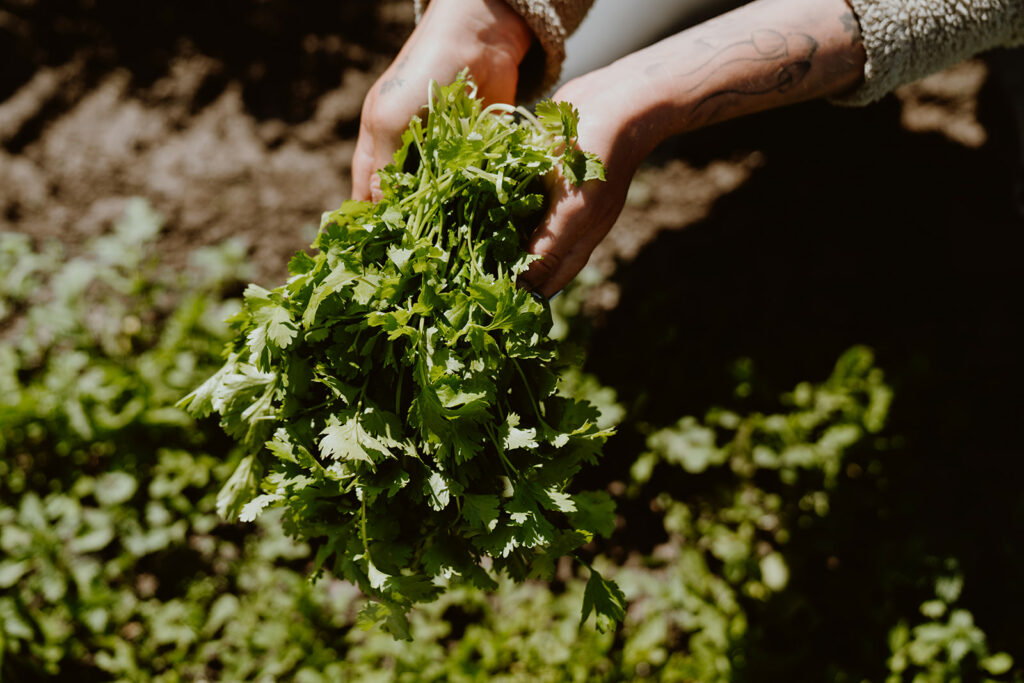
Cilantro, also known as coriander, Mexican parsley or Chinese parsley, is a member of the parsley family, native to the southern Mediterranean. While its taste is a matter of controversy, cilantro’s bright flavor with sage, parsley and citrus notes is indispensable to several beloved global cuisines.
SEASONAL IN SOUTHERN CALIFORNIA
PLANT: September through June
HARVEST: January through December
HISTORY
Cilantro is believed to be one of the first herbs used by humankind, with records of its use as far back as 5000 B.C. Mentioned in early Sanskrit writings, cilantro is a mainstay of Indian and Central Asian cooking; large amounts of the leaves are used to add depth of flavor to cooked dishes, while the seeds are ground for use in the spice blend garam masala. The Romans spread cilantro throughout Europe, and it was one of the first herbs to arrive in the Americas.
NUTRITION
Cilantro is rich in vitamins A, C and K, as well as calcium, potassium, iron, magnesium, and manganese. Cilantro also boasts antibacterial properties and has been used for both insomnia and anxiety relief in traditional medicine.
STORAGE
Cut off the ends of cilantro stems, place in a glass of water, and store in the refrigerator for up to 3 weeks.
COOKING
Delicate cilantro leaves are typically used raw or added to cooked dishes right before serving. Torn fresh cilantro is a bright topping for tacos, enchiladas, and other Mexican dishes, as well as Indian and Thai curries, Moroccan tagine, and a variety of Middle Eastern dishes. It is a welcome addition to condiments such as chutney, salsa, and pesto. Cilantro pairs well with vegetables and fruits such as tomato, avocado, cucumbers, cauliflower, and spinach.
Cucumber
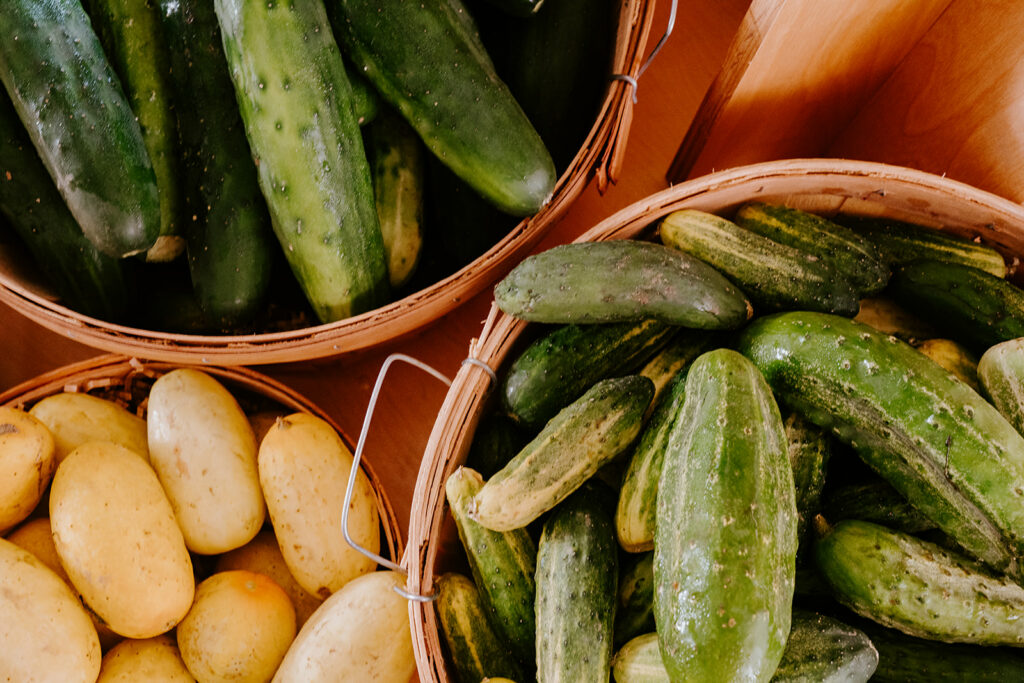
One of the world’s most ancient foods, the cucumber has been bred from a bitter vining gourd into a juicy, cooling vegetable with an herbaceous sweetness.
SEASONAL IN SOUTHERN CALIFORNIA
PLANT: February through September
HARVEST: May through October
HISTORY
Native to India, the cucumber has been grown as a food source for over 3000 years. A staple of the ancient Egyptian diet, the cucumber was also used to make liquor by cutting a hole in the ripe fruit, mashing the inside with a stick, plugging the hole, and letting it ferment. The cucumber has long been a favorite of royalty—the Roman emperor Tiberius ate cucumbers every day, and Catherine of Aragon, the first wife of King Henry VIII, demanded them as well. Cucumbers were brought by Columbus to the New World, first to Haiti and later to the Americas. By the time of American colonization, eight varieties of cucumbers were being grown in the United States. For a brief period in the 18th century, medical journals warned that it was dangerous to eat uncooked cucumbers. However, by the 19th century, cucumbers had made a comeback, thanks in part to the newly formed Heinz company adding cucumber pickles to their product list.
NUTRITION
Thanks to their high water content, cucumbers have a lower concentration of nutrients than many vegetables. That said, they are a good source of vitamins A and C, iron, and calcium, as well as various antioxidants.
STORAGE
Wrap unwashed cucumbers in a dry towel, seal in a plastic bag, and store in the refrigerator crisper for up to 2 weeks.
PREPARATION
While cucumbers are mainly used raw in salads or pickled, they are also delicious when grilled and served with herbs, fresh cheese or yogurt, and olive oil. Cucumbers can be juiced, blended into smoothies, or sliced and added to water or seltzer for a refreshing taste. Cucumbers are also popular when spiralized into vegetable “noodles” and used as a replacement for spaghetti in cold pasta dishes. Other uses for cucumbers include blending with green tomatoes into gazpacho, combining with garlic and yogurt for tzatziki, and dusting with chamoy for pepinos locos.
COOKING
Slice cucumbers into rings or small sticks. Toss with salt and let drain for at least 30 minutes. Add to a bowl with thinly sliced red onion, chopped cilantro, and crushed peanuts. Season with a mix of rice vinegar, sugar, sesame oil, crushed garlic, and Korean chili paste. Toss to coat, and serve cold.
PRO TIPS
To remove cucumber bumps (or “burps”) without peeling, simply rub a cloth or vegetable brush along the length of the fruit until cucumber is smooth to the touch.
Dandelion
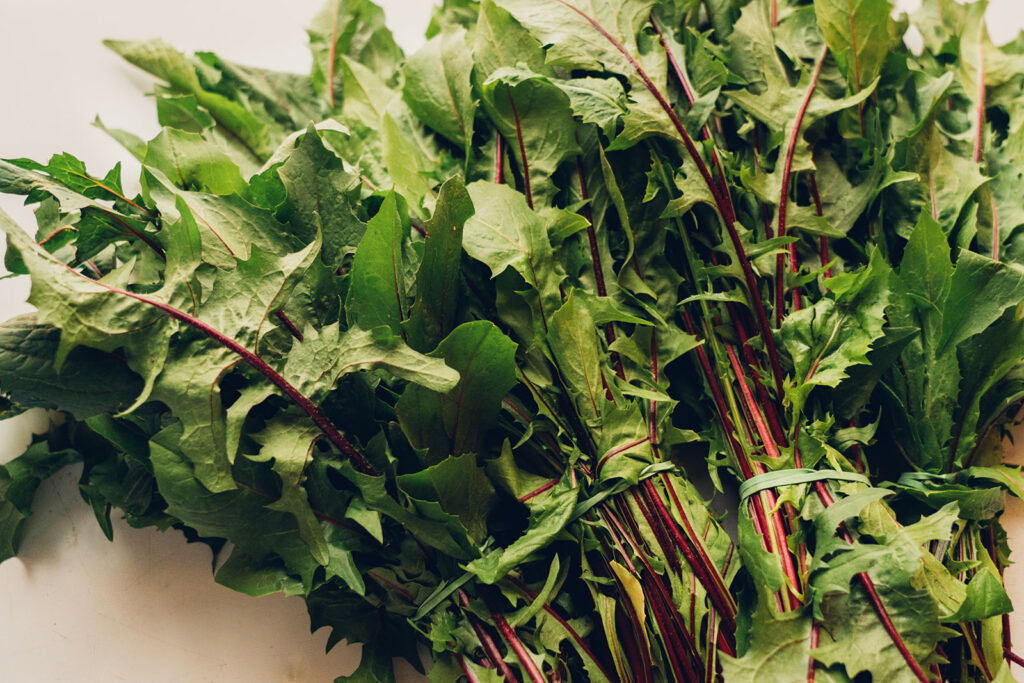
While mainly considered a weed today, dandelion was historically revered as a food with potent health benefits. Their abundant growth and numerous culinary and medicinal uses made them a primary ingredient in everything from stews and salads to pesto, jelly, syrup, and even wine.
SEASONAL IN SOUTHERN CALIFORNIA
PLANT: January through December
HARVEST: January through December
HISTORY
The name of dandelion comes from the French phrase dent de lion, or lion’s tooth, thanks to the leaves’ serrated edges. The plant was also known as pissenlit, or “pee the bed,” thanks to its use as a diuretic. While the plant is native to Eurasia, its aggressive pollination led to it being introduced via European migration to North America, South America, India, and Australia.
NUTRITION
Dandelion is high in vitamins A, C, K and B2, contains more protein and iron than spinach, and includes a sugar compound called taraxacin that stimulates digestion. In traditional Chinese and Native American medicine, dandelion is used to treat stomach and liver conditions, while modern herbalists also use it to heal heartburn, gastrointestinal disorders, inflammation, and diabetes.
STORAGE
Wrap dry dandelion leaves in a lightly dampened paper towel and store in a half-sealed bag in the coldest part of the refrigerator for 3 to 5 days.
PREPARATION
The bittersweet flavor of dandelion leaves is an excellent way to cut the richness of heavier foods like bacon, oily fish, hard cheeses, or avocado. Their bitter flavor also adds dimension to mild flavors such as beans and lentils, grains, and pasta. They are a powerful addition to green juices and smoothies—just make sure to include an apple or grapefruit to help cut the bitterness.
COOKING
Sauté torn dandelion leaves with olive oil and garlic. Transfer to a large bowl, adding lettuce or other greens if desired. Add a scoop of warm white beans, crumbled bacon or pancetta, toasted bread cubes, and a soft poached or fried egg. Toss with more olive oil, salt, and a squeeze of fresh lemon.
PRO TIPS
Taste dandelion greens before using to assess their bitterness. If you find them too bitter, remove stems and blanch greens in a pot of salted boiling water for 1 to 2 minutes, then plunge greens into an ice bath to avoid overcooking.
Dill
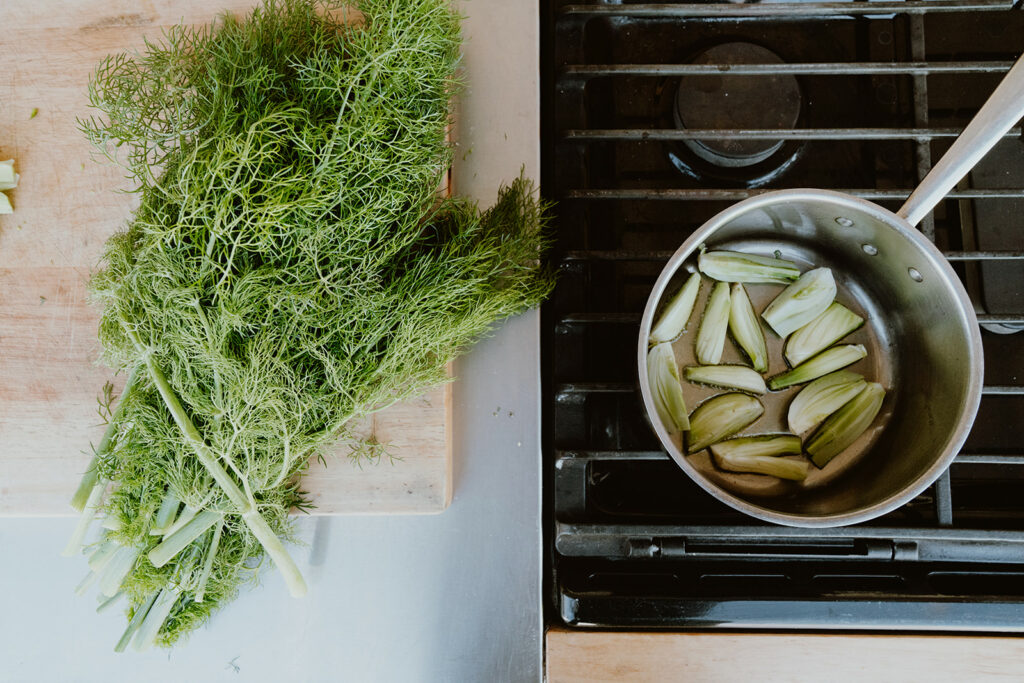
With its feathery appearance and cool, herbaceous taste, dill has long been an iconic springtime herb. A member of the parsley family, dill is native to the southern Mediterranean, though it is today most closely associated with Eastern European and Scandinavian cuisine.
SEASONAL IN SOUTHERN CALIFORNIA
PLANT: January through December
HARVEST: January through December
HISTORY
In the ancient world, dill had a variety of meanings and uses. Ancient Egyptians used dill to ward off witches, while to dill signified wealth to the Greeks and good luck to the Romans, who spread the herb throughout their empire. English immigrants brought dill to North America, where the seeds were often chewed during long religious service to dull the appetite. Strongly associated today with Eastern European and Nordic cultural cuisine, the word dill comes from an old Norse word meaning to soothe or lull.
NUTRITION
Dill is a good source of vitamins A and C, as well as several antioxidants. Traditional medicine uses dill seed to freshen breath, soothe stomach complaints, alleviate colic and indigestion in babies, and stimulate milk production in breastfeeding women.
STORAGE
Snip the ends of dill stems, place in a jar with 1 to 2 inches of water, and store at room temperature for about 2 weeks. Alternatively, lightly spray dill stems with water, wrap loosely in paper towels, and store in a sealed plastic bag for up to 1 week.
COOKING
While very popular as a pickling herb and an ingredient in classic tuna or egg salad, dill is also a natural pairing with spring and summer vegetables, such as asparagus, spinach, tomatoes, and summer squash. It’s light, herbaceous flavor complements the seafood well, especially cold-water fish like herring and salmon, as well as eggs and dairy. It blends well into cold dishes with sour flavors, such as Greek tzatziki and Eastern European borscht.
PRO TIPS
If not using a whole sprig of dill, separate leaves from stem and chop finely to use. 1 tablespoon of fresh dill substitutes for 1 teaspoon dried.
Eggplant
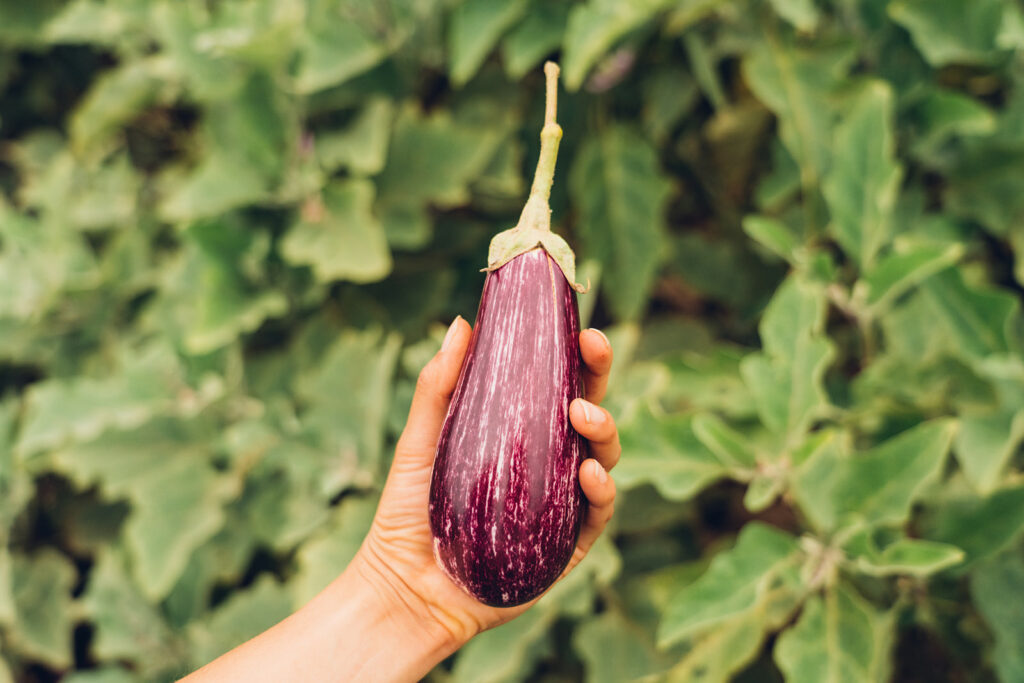
A member of the nightshade family (which includes tomatoes, peppers and potatoes), the eggplant started as a spiny orange berry with a bitter flavor, but was bred over time into the glossy purple fruit we know today. Known in Europe as aubergine, the term “eggplant” came into use in 1763, as the white varietals bore a strong resemblance to hen’s eggs.
SEASONAL IN SOUTHERN CALIFORNIA
PLANT: April through August
HARVEST: July to October
HISTORY
The eggplant is believed to have originated somewhere in southern Asia or perhaps in Africa. It has been cultivated in India and China for more than 1500 years. Along with its culinary uses, the black dye from eggplant skin was used to make a black dye that fashionable Chinese ladies used to stain their teeth. Middle Eastern traders brought the eggplant to Turkey, and later to Africa and Europe, where it was initially believed (along with tomatoes) to cause madness. Spanish invaders brought the eggplant to the New World. By the early 1800s, both white and purple varieties of eggplant were commonly grown in American gardens.
NUTRITION
Eggplants include a surprising range of nutrients, including vitamins B6, C, and K, vitamin B6, as well as magnesium, manganese, phosphorus, copper, folic acid, potassium, and more.
STORAGE
Wrap the whole eggplant in a dampened paper towel and store in an unsealed container in refrigerator crisper for up to 7 days.
PREPARATION
The subtle flavor of eggplant pairs well with spicy, sour, smoky and rich flavors from a wide range of cultural cuisines. Eggplant serves as the foundation of many hearty Mediterranean dishes, among them Greek moussaka, French ratatouille, Lebanese baba ghanouj, and Italian eggplant parmigiana. Chunks of eggplant can be added to pasta sauce as well as curries, stir-fry, and soups. Eggplant is also excellent when simply peeled, brushed with olive oil, and baked, roasted, grilled, or even smoked.
COOKING
Slice one large Italian eggplant lengthwise into 4 thick slices (or halve 2 to 3 Asian eggplants), brush with olive oil and season with salt and pepper. Grill over an open flame until meat is lightly charred and skin is crispy. Cut diagonally into smaller slices and arrange on plates. Drizzle with hot sauce and top with runny fried eggs. Top with more hot sauce and chopped cilantro and dill.
PRO TIPS
Crowding eggplant slices together while cooking will cause eggplant to steam, rather than brown. To achieve crispy edges and tender insides, space slices apart while cooking.
Escarole
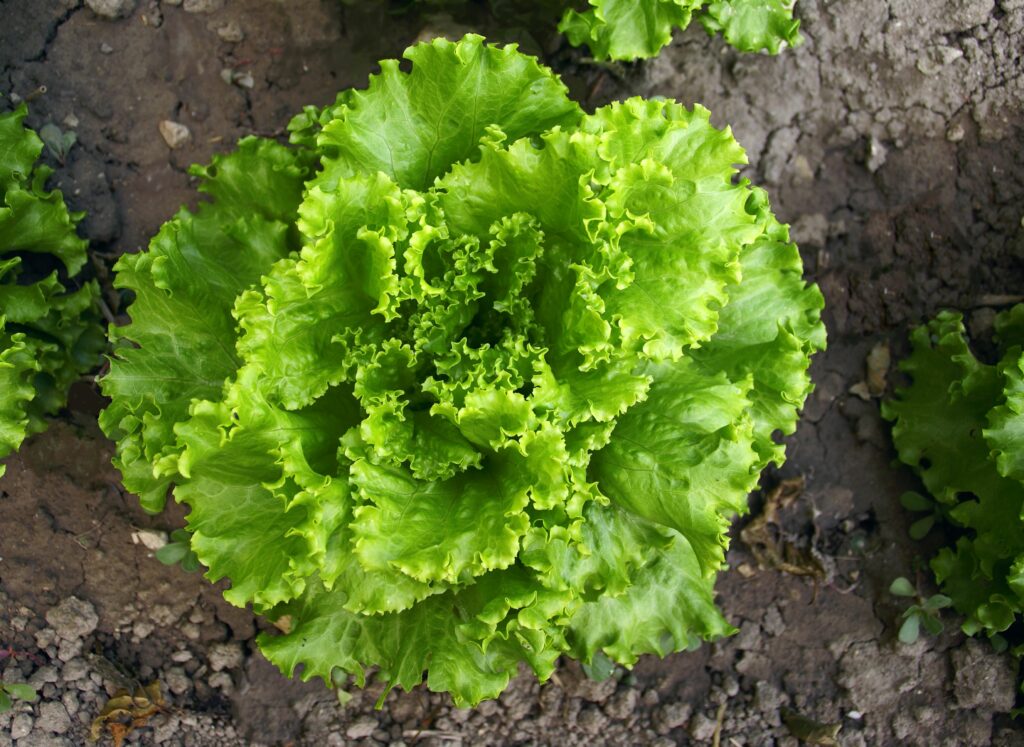
A member of the chicory family, escarole is believed to be native to the East Indies, and as used as a vegetable as early as ancient Egypt. Widely cultivated in both Italy and England from at least the 1500s, escarole was brought to America by European colonists. Escarole’s dark green outer leaves are typically quite bitter, but lighten in color and flavor toward the inner heart.
SEASONAL IN SOUTHERN CALIFORNIA
PLANT: June through November
HARVEST: May through November
HISTORY
Escarole is believed to be native to Sicily. From a very early period it was used as a vegetable by the Egyptians, Greeks and Romans, then spread to the British Isles in the 1500s and was brought to North America by English colonists.
NUTRITION
Escarole is rich in many minerals and vitamins, especially folate. It’s also a good source of B vitamins, as well as vitamins A, C, and K.
STORAGE
Wrap escarole head in a dampened paper towel and store in an unsealed plastic bag in the refrigerator crisper for up to 4 days.
PREPARATION
Escarole greens can be used raw in salads or cooked like other bitter greens. It pairs well with strong, salty flavors such as capers, anchovies, and cured meats and fish. A traditional escarole preparation is the Italian New Year’s Day soup known as straciatella, which combines escarole leaves and a beaten egg swirled into hot chicken broth. It is also delicious when braised slowly and served with stewed beans, pesto or meatballs.
COOKING
Blanch whole escarole leaves in salted boiling water for 2 minutes, then remove and plunge into an ice bath to stop cooking. Let drain and cool, then add a mixture of sauteed black olives, capers, pine nuts and raisins to the base of each leaf. Sprinkle olive mixture toasted bread crumbs and crumbled Parmesan cheese, then roll leaves like a burrito from the base to the tip. Arrange rolled escarole leaves in a baking pan, sprinkle with more bread crumbs and cheese, cover pan with foil, and bake at 375 degrees until toppings are golden brown.
PRO TIPS
If escarole is too bitter for your taste, a little sweetener (such as honey or dried fruit) added to your recipe will help balance the flavor.
Fava Beans
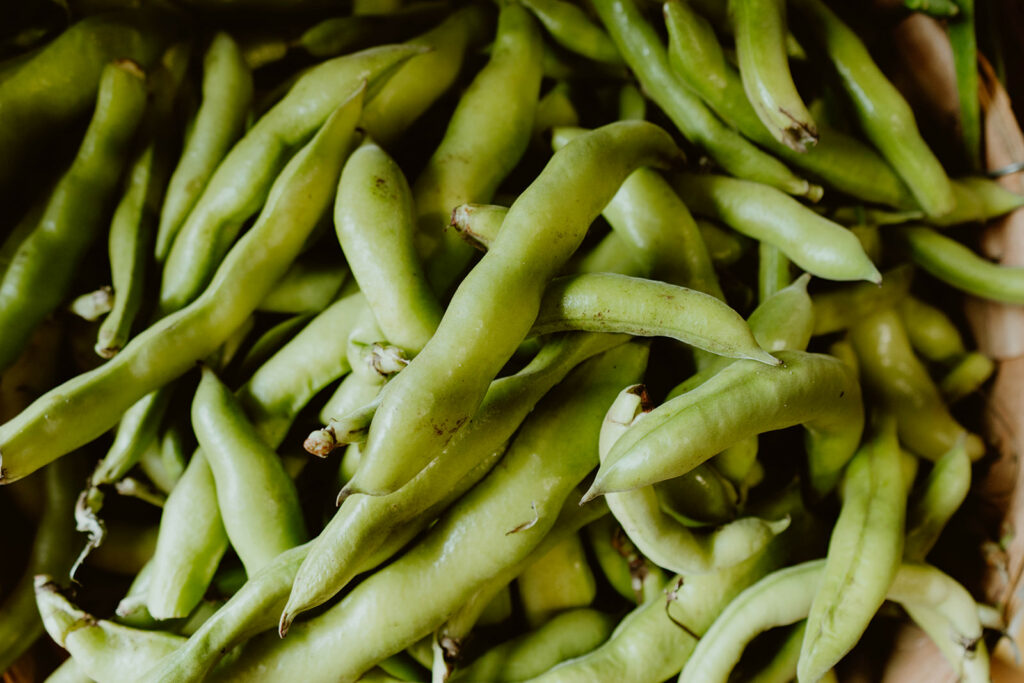
Fava beans are among the world’s oldest cultivated plants, with evidence of playing a part in human diets as far back as 6000 B.C. While many home cooks find their large size intimidating, the rich taste and smooth texture of fava beans have made them a popular seasonal ingredient for fine restaurants around the world.
SEASONAL IN SOUTHERN CALIFORNIA
PLANT: October through December
HARVEST: January through December
HISTORY
The fava bean enjoys a place of honor in many traditional cultures. The ancient Egyptians offered fava beans to the gods, and used them as a temptation exercise to purify priests. It was also believed by Mediterranean people that eating fava beans helped ward off malaria (a belief borne out by later scientific studies). Fava beans were used as the symbol for the Christ child baked into Twelfth Night Cake or King Cake, leading to their general use as a symbol of good luck. To this day, fava beans are the central dish for Sicily’s St. Joseph Day celebration, and Sicilian tradition adds that keeping a fava bean in the wallet will bring good fortune.
NUTRITION
Along with significant protein content, fava beans are an excellent source of vitamins B6 and K, as well as zinc, copper, iron, magnesium and folate.
STORAGE
Store unshelled fava beans in a plastic bag or paper sack in the refrigerator for up to 10 days.
PREPARATION
Traditional uses of fava beans include Italian risotto, Egyptian falafel, Lebanese ful medames, and Indian dal. Steamed fava beans add soft, chewy texture to salads, grain bowls, and pasta dishes. They can also be baked or fried into fritters, puréed into hummus, or grilled in the pods and eaten like edamame.
COOKING
Steam fava beans, then add to a frying pan with plenty of olive oil, salt, garlic, and chunks of spicy sausage. Fry together until the edges of beans and sausage are crisp, then remove and sprinkle with wine vinegar. Serve as a side dish or use as a filling for flatbread.
PRO TIPS
After being shelled and cooked, fava beans will still have a thin, translucent skin around them. Removing this skin before eating will make the texture more palatable and rid the bean of any residual bitterness.
Fennel
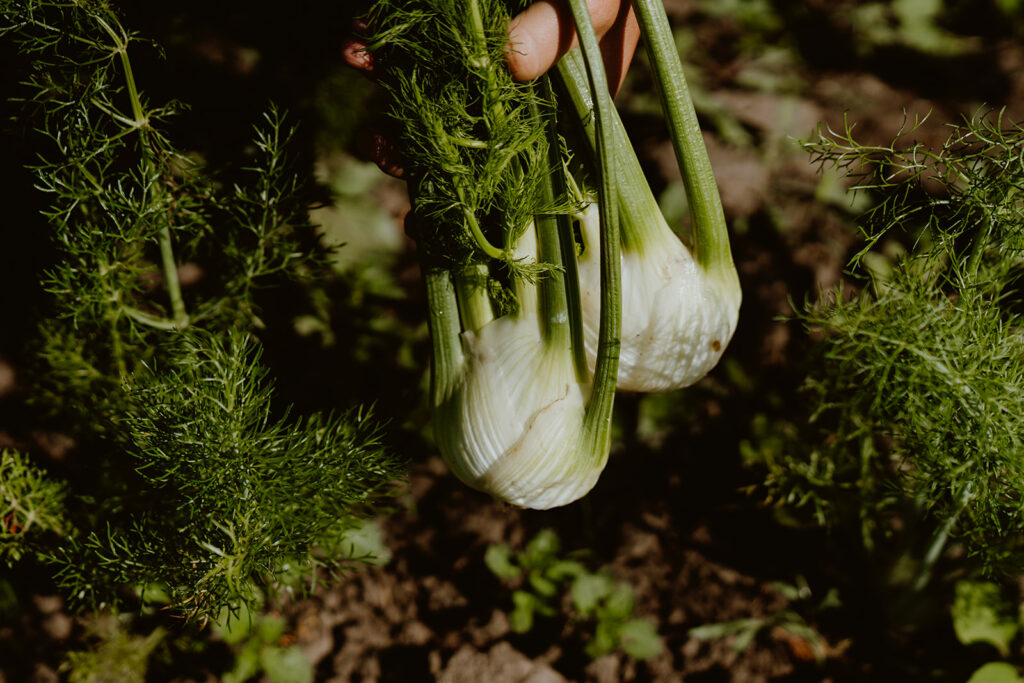
Fennel is a member of the carrot family, related to other aromatic plants such as cumin, dill and caraway. Native to southern Europe, fennel has a sweet, earthy taste with notes of anise.
SEASONAL IN SOUTHERN CALIFORNIA
PLANT: August through May
HARVEST: May through October
HISTORY
Since ancient times, fennel has been used for culinary, medicinal and magical purposes. A common vegetable in Egyptian, Greek and Roman diets, fennel was also used to treat snakebites, suppress appetite, and improve eyesight. Fennel spread quickly around the Western world due to its open pollination. By the Middle Ages, fennel was not only a common kitchen ingredient, but was also hung in doorways to drive away evil spirits. Brought to North America by English settlers, fennel was commonly included in kitchen gardens, though it was mainly used for its seeds. By the 19th century, fennel was used similarly to celery, included in salads, soups, and stews.
NUTRITION
Fennel is a good source of vitamin C, and also contains high amounts of potassium, magnesium, manganese, and calcium. In traditional medicine, fennel has been used as an aphrodisiac and to encourage menstruation and lactation.
STORAGE
Place fennel stalk in a large jar or vase with enough water to cover the base of the bulb, and store for up to 1 week. Alternatively, separate fennel stalks from the bulb, wrap separately in dampened paper towels, and store in sealed plastic bags for up to 4 days.
PREPARATION
Fennel leaves are an aromatic addition to salads, spreads, and dairy or egg dishes, while stems can be grilled with fish, meats and vegetables. Both stems and leaves can be added to cured olives, as well as pickles, sauerkraut and other fermented foods. The crunchy bulb can be sliced and served raw in both fruit and vegetable salads. It can also be segmented and roasted with root vegetables.
PRO TIPS
Try drying fennel stalks in the oven at 200 degrees for about 3 hours, then let cool and continue drying overnight. Use stalks as skewers for grilling fish or meat, or add to flavor stock, broth or infused oils.
Green Beans
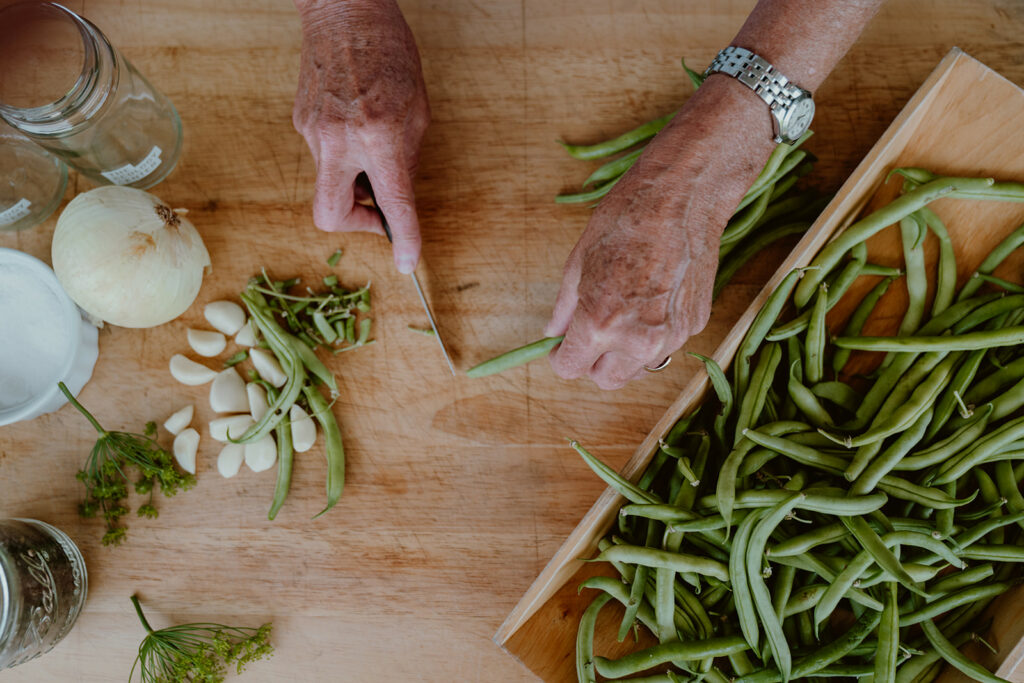
Green beans, also known as string beans, snap beans, or French beans, are the immature pods of bean plants, picked before the dry bean has a chance to grow inside. Today, the green bean has been bred into over 130 varieties that are grown throughout North America, South America, and Europe.
SEASONAL IN SOUTHERN CALIFORNIA
PLANT: February through November
HARVEST: June through October
HISTORY
The green bean originated in Central America and was cultivated in Mexico and Peru for thousands of years before European invaders brought it back to Europe. By the 17th century, the green bean was being grown all over the Mediterranean region.
NUTRITION
Green beans are high in vitamins A, C, and K, as well as folic acid and fiber.
STORAGE
Unwashed, untrimmed green beans can be stored in a reusable container in the refrigerator crisper for up to 7 days.
PREPARATION
Green beans add flavor, nutrition, texture, and color to any dish. Add whole or segmented green beans into soups, curries, pasta sauces, stir-fries, and casseroles. Roast whole green beans or blister them in a cast-iron skillet with plenty of olive oil, garlic, and parmesan. Steamed, chilled and salted green beans are a delicious addition to salads and grain bowls. They can also be served raw with your favorite veggie dip, or pickled with sugar, spices, and herbs into “dilly beans.”
COOKING
Wash green beans dry thoroughly, and trim ends. Toss in flour until dusted all over, dip into beaten egg, then coat in a mixture of panko and Parmesan. Spread in a single layer on a greased baking sheet, and roast at 425 degrees until the coating begins to brown. Season with salt, garlic powder, and red pepper flakes, and serve hot.
PRO TIPS
To get your green beans perfectly al dente, cook them the way you would cook pasta: drop into already boiling water with a pinch of salt added. Boil for 8 to 10 minutes, remove immediately from the water, and rinse with cold water or plunge into an ice bath for a few seconds to stop the cooking process. Beans will be brilliant green.
Lemon Verbena
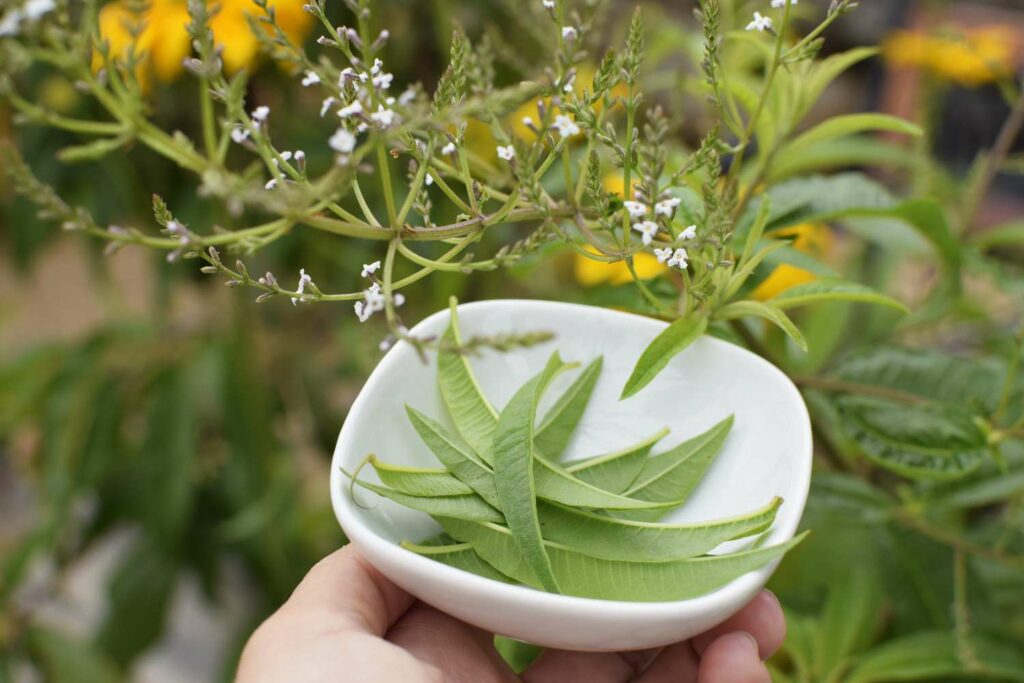
Native to the west coast of South America, lemon verbena is a perennial herb with oil-rich leaves that produce a bright, citrusy flavor. It also goes by the names cedron and yerba Luisa.
SEASONAL IN SOUTHERN CALIFORNIA
PLANT: May through September
HARVEST: January through December
HISTORY
Brought back to Europe by Spanish explorers, lemon verbena was planted in the royal botanical gardens of Madrid. After being shared with botanists in France and Britain in the late 18th century, lemon verbena became a favorite plant of the Victorian era, grown in greenhouses around London, used in fragrant bouquets, and even sewn into women’s dresses.
NUTRITION
Lemon verbena is known for a rich collection of antioxidants and bioflavonoids. One of its primary compounds, luteolin, possess anti-inflammatory and anti-tumor properties that destroy free radicals. The herb is used medicinally to ease digestive disorders, joint pain, insomnia, fever, respiratory and skin issues.
STORAGE
Stand lemon verbena sprigs in a glass of water and keep for up to 1 week. Alternatively, wrap sprigs in a damp paper towel, seal in a plastic bag or jar, and keep in the refrigerator crisper for 2 days.
PREPARATION
Lemon verbena adds a subtle citrusy flavor to fish and poultry dishes, vegetable marinades, and salad dressings. It is also a common flavoring for tea, jelly, syrup, whipped cream, and liqueur, and is a main ingredient in potpourri.
PRO TIPS
Separate desired number of leaves from stem and chop finely or use whole. 1 tablespoon of fresh lemon verbena substitutes for 1 teaspoon dried.
Lettuce
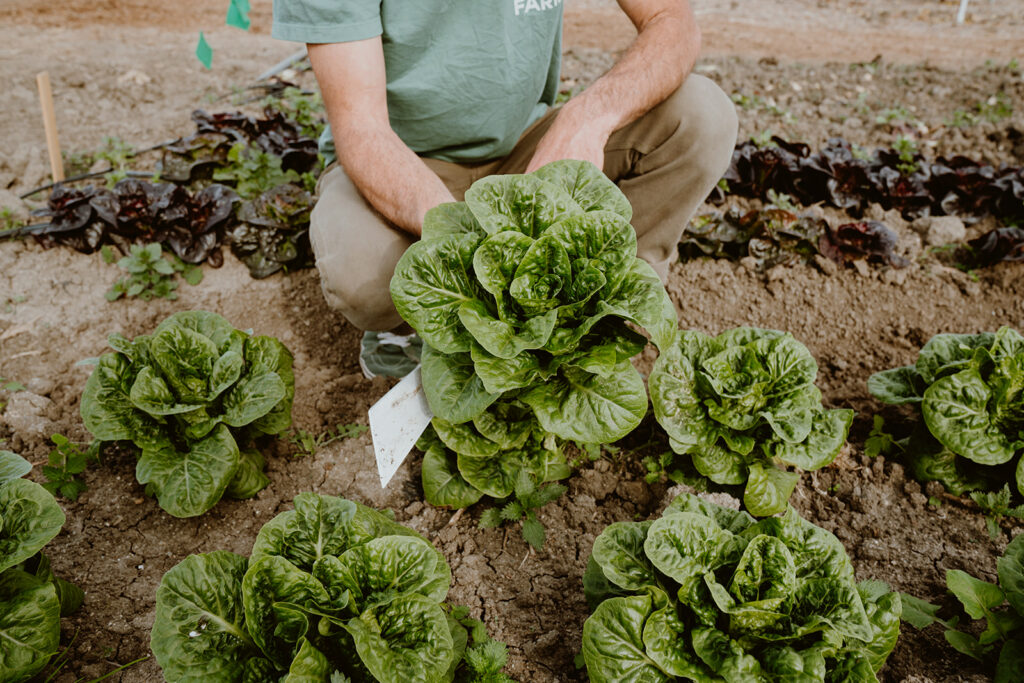
While in ancient times, lettuce was used only for the medicinal value of its seeds (the leaves were considered too bitter for human consumption), it is likely the most ubiquitous green vegetable in the Western world today. The three main categories—head lettuce, loose-leaf, and cos/romaine—all offer a light taste, crisp texture, and soft yet firm structure.
SEASONAL IN SOUTHERN CALIFORNIA
PLANT: January through December
HARVEST: January through December
HISTORY
Lettuce was first grown by ancient Egyptians as an offering to the gods. This use was passed along to the cultures of ancient Greece and Rome, who included lettuce in the origin stories of their deities. In 86 A.D., Roman emperor Domitian began serving lettuce salads at feasts to stimulate the appetite and encourage digestion. This led to Roman farmers developing many other varieties of lettuce, including the red-leaf varieties common today. More cultivars were created throughout the Middle Ages, and their ease of growth led to a rapid spread throughout the civilized world. By the 1800s, seed catalogs had begun an unscrupulous practice of renaming common lettuce varieties to trick farmers into thinking they were buying several different seeds. This, along with the subtle distinctions between varieties, makes it challenging for seed historians to trace true heirloom lettuces.
NUTRITION
While the nutritional value varies with the specific cultivar, lettuce generally is high in vitamin A, C, and K, as well as folate, calcium, magnesium, and potassium.
STORAGE
Submerge the whole lettuce head in fresh cold water, rinse thoroughly, then dry in a salad spinner until leaves are barely damp. Cover lettuce head with a paper towel to absorb moisture, and store in a half-sealed or perforated plastic bag in the refrigerator crisper for up to 5 days.
PREPARATION
Despite being best known for use in raw salads, sandwiches, and wraps, lettuce is also a handy addition to soups, stir-fry, dal, juices/smoothies, and even pesto or chutney. Well-structured leaves with firm stems can be cooked on the grill, or used as cups to hold ground meat, dip, or other fillings.
COOKING
Slice a firm lettuce variety (such as romaine or oak leaf) down the middle lengthwise, keeping the core intact. (If the lettuce head is very large, slice into quarters.) Brush lettuce sections with olive oil and crushed anchovy, if desired, and sprinkle all over with salt. Place cut side down on a hot grill for 2 to 3 minutes, pressing down to ensure a good sear. Flip and grill the opposite side for another 2 to 3 minutes. Remove from grill and top, if desired, with grated or shaved Parmesan cheese, halved cherry tomatoes, chunks of avocado, and garlic-soaked bread crumbs. Add additional olive oil, lemon juice, and salt, and pepper, and serve warm.
PRO TIPS
Slicing lettuce with a metal knife causes a reaction that encourages discoloration and wilting. To avoid this, tear lettuce leaves by hand rather than cutting them with a knife.
Melon
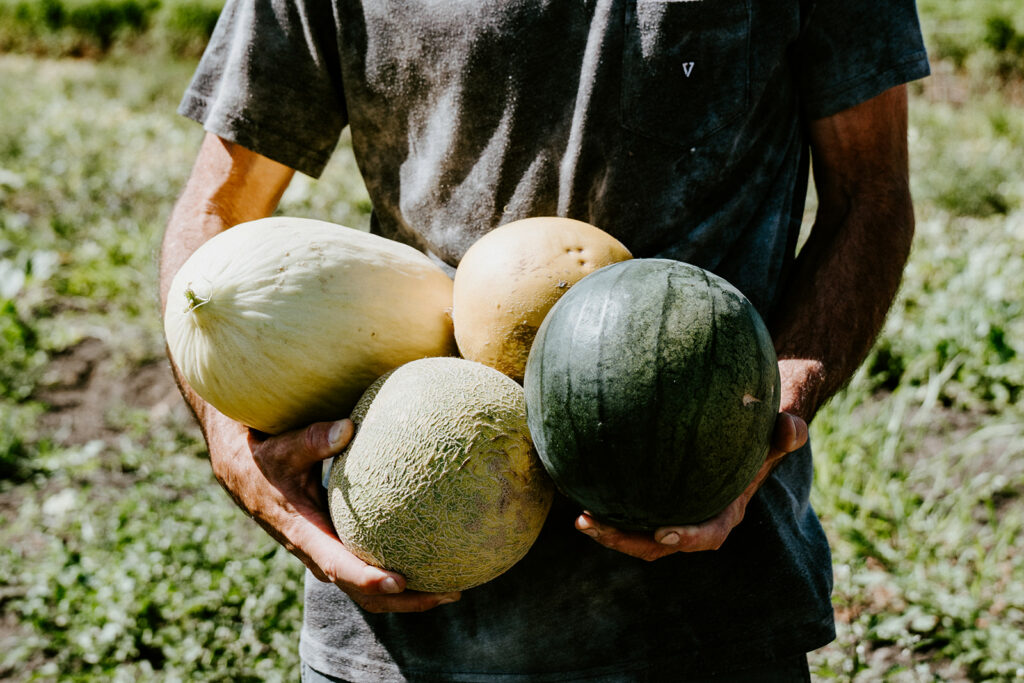
Muskmelons, so called for their strong, sweet fragrance when ripe, are technically a vegetable, related to cucumbers and squash. Their origins are steeped in mystery, and today there are at least 30 varieties being grown around the world.
SEASONAL IN SOUTHERN CALIFORNIA
PLANT: May through July
HARVEST: July through September
HISTORY
It is not known precisely where melons originated—theories range from the Middle East to India, Central Asia, and North Africa. Cultivated since ancient times, melons were considered a sacred food by the Egyptians, Melon seeds were exchanged throughout trade routes of the ancient world. By the 1st century, melons were cultivated over three continents, with many varieties being bred. Columbus carried melon seeds on his second voyage to North America, while about the same time King Charles VIII of France is said to have introduced melons into northern Europe. English settlers planted melon in the gardens of Virginia and Massachusetts colonies, and it was adopted by Native Americans by the mid-17th century.
NUTRITION
Melons are a good source of vitamins A and C, as well as folate, potassium, and antioxidants.
STORAGE
Whole, uncut melon can be stored in the refrigerator for up to one week, or at room temperature for up to two weeks. Cut melon should be wrapped or enclosed tightly, refrigerated, and used within 5 days.
PREPARATION
The herbaceous sweetness of musk melons makes them a good pairing with savory dishes as well as sweet. Serve ripe melon slices with thinly sliced cured meats, such as prosciutto, with a drizzle of olive oil on top. Toss melon chunks with shrimp and other seafood, garlic, lime juice, and cilantro for a sweet take on ceviche. Combine melon with other summer vegetables such as sweet corn, avocado, cucumbers, zucchini, and bitter leafy greens like radicchio and endive. Crush melon for use in Aguas Frescas or spritzers, muddle it with herbs for a summer cocktail or freeze with chopped herbs into popsicles.
COOKING
Peel the melon and chop into chunks. Toss melon chunks with shaved red onion, honey, white vinegar, salt, chopped mint, and chili flakes. Serve with burrata mozzarella or mascarpone cheese.
PRO TIPS
Pro Tips
If you find that your ripe melon lacks flavor, simply sprinkle slices with salt before eating. The salt will bring out the flavor and highlight the melon’s sweetness.
Oregano
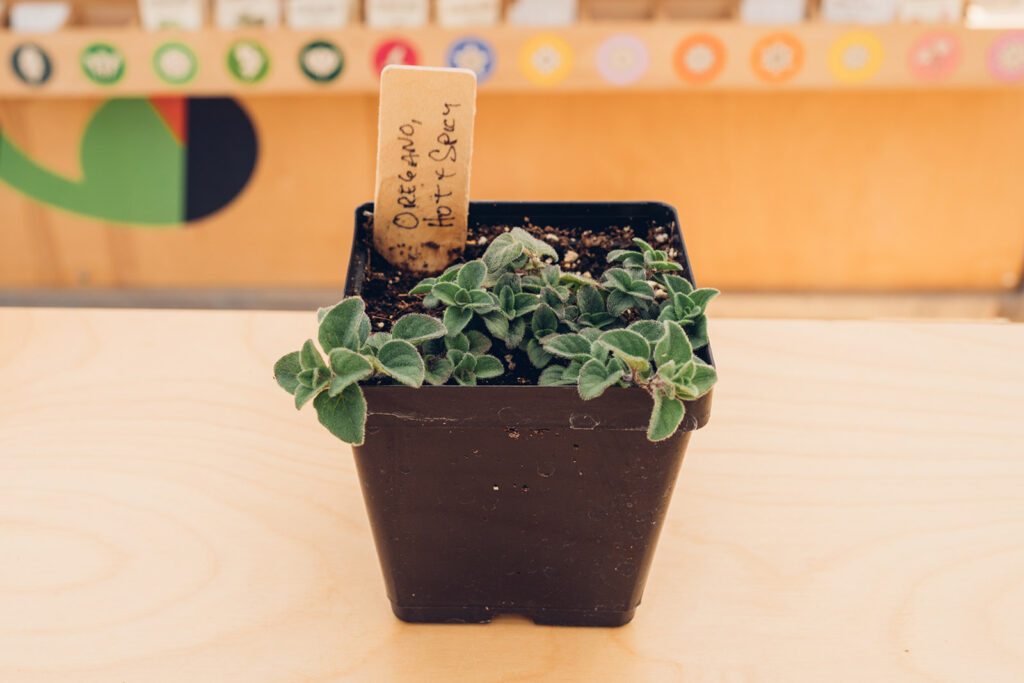
Native to the Mediterranean region and western Asia, oregano is a perennial herb related to the mint family. It is also known as wild marjoram or Spanish thyme.
SEASONAL IN SOUTHERN CALIFORNIA
PLANT: May through December
HARVEST: January through December
HISTORY
Named for Greek words meaning “joy of the mountains,” oregano has long been a flavoring for Mediterranean cuisine. It was readily adopted by the Romans, who spread it throughout the world, including Europe, North Africa, and Asia.
NUTRITION
Along with being an excellent source of vitamins E and K, manganese, iron, and calcium, fresh oregano is highly antibacterial and contains many antioxidants and phytonutrients that help infection and cell damage.
STORAGE
Stand fresh oregano sprigs upright in a container of water for up to 3 weeks. Alternatively, roll in a damp paper towel, seal in a plastic bag or jar, and keep in the refrigerator crisper for up to 1 week.
PREPARATION
Often used in Greek, Italian and Mexican cuisine, oregano has a spicy, pungent flavor. It is a key ingredient in tomato sauces, marinades, and vinaigrettes. It is excellent for adding flavor to grilled meat; you can also add a sprig or two to the inner cavity of chicken or fish before cooking. Oregano is also used as a cure for indigestion and respiratory illness.
PRO TIPS
If not using a whole sprig of oregano, separate leaves from the stem and chop finely to use. 1 tablespoon of fresh oregano substitutes for 1 teaspoon dried.
Parsley

Parsley is a member of the carrot family, native to the Mediterranean region of southern Europe and Asia. Its fresh, astringent taste, known to freshen the breath and stimulate digestion, led to its commonplace use as a plate garnish.
SEASONAL IN SOUTHERN CALIFORNIA
PLANT: January through December
HARVEST: January through December
HISTORY
The name parsley comes from Greek words meaning rock celery because the plant thrives on rocks and walls. The ancient Greeks feared parsley as a symbol of death, thanks to its use as an aromatic to cover the smell of disease and decay. The Romans are credited with the first culinary use of parsley to aid in digestion; parsley was also used at orgies to mask the smell of alcohol on the breath. Some credit Holy Roman Emperor Charles the Great for spreading the use of parsley around the Western world by growing it all over his palace grounds, while others give credit to Catherine de Medici for bringing it from Italy and incorporating it into French cooking.
NUTRITION
Parsley is rich in vitamins A and C, as well as compounds that clear toxins, reduce inflammation, and inhibit histamines and free radicals from the body. Since ancient times, parsley has been used as an antidote to poison, as well as a general tonic for digestion, urinary tract health, and dry hair and skin.
STORAGE
Snip off ends of parsley stems, place in a jar with 1 to 2 inches of water, and store at room temperature for up to 3 weeks. Alternatively, wrap parsley sprigs in a damp paper towel, seal in a plastic bag or jar, and keep in the refrigerator crisper for up to 2 weeks.
PREPARATION
Parsley is a key herb in French cooking and is included with tarragon, chives, and chervil under the term fines herbs. Parsley adding fresh flavor to spring and summer vegetables such as peas, green beans, tomatoes, peppers, eggplant, and summer squash, as well as seafood, poultry, and egg dishes. It is the flagship ingredient in French persillade and Italian gremolata, both sauces that combine parsley with garlic and other ingredients to flavor roasted or broiled meat and poultry. It is also a popular ingredient in green juices, thanks to its cleansing effect and use as a digestive stimulant.
PRO TIPS
If not using a whole sprig of parsley, separate leaves from the stem and chop finely to use. 1 tablespoon of fresh parsley substitutes for 1 teaspoon dried.
Peas
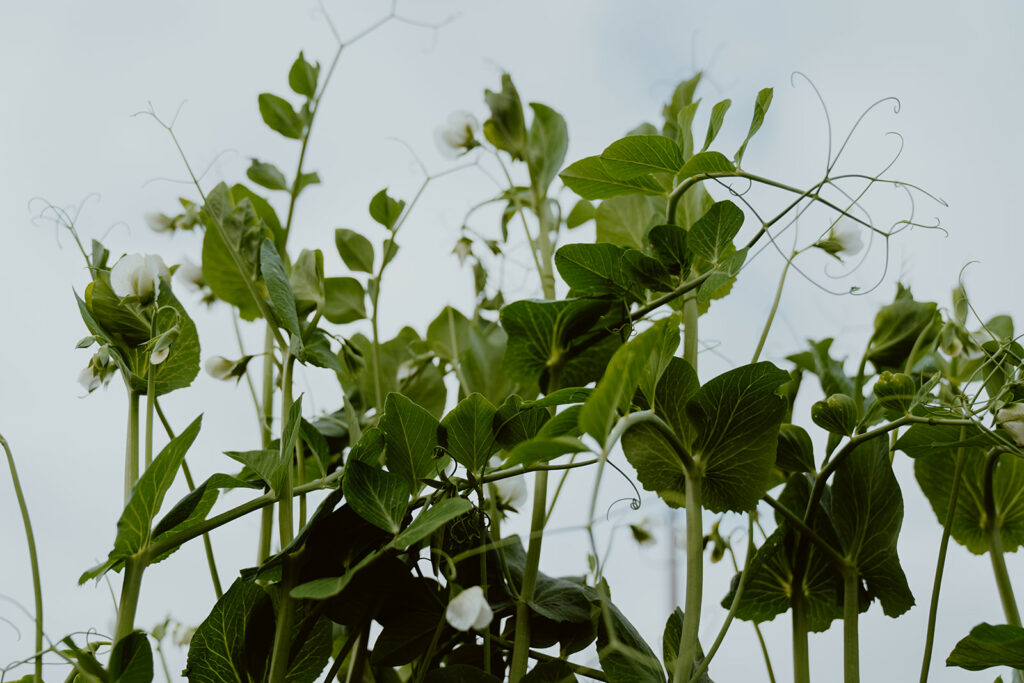
One of the world’s oldest cultivated crops, the pea is a legume that has fostered the development of agriculture and science throughout history. Along with providing reliable nourishment throughout times of famine, peas were the basis of Mendel’s 1856 experiments in genetics, as well as the birth of frozen food preservation in the 1920s.
SEASONAL IN SOUTHERN CALIFORNIA
PLANT: January through December
HARVEST: October through June
HISTORY
Native to the Mediterranean region, there is evidence of pea cultivation dating as far back as the late Neolithic Period. By the Middle Ages, peas were a staple survival crop in Europe, the Middle East, and North Africa. Initially, only the dried seeds were eaten by peasants, but by the early days of modern Europe, fresh green peas were eaten as a delicacy. This led to the development of new cultivars, known as English peas, meant to be eaten fresh. By the 19th century, the modern split pea—green peas with their skins removed to encourage a natural divide in the legume—had become a common kitchen ingredient around the world.
NUTRITION
Peas are an excellent source of vitamin A, B1, and C, as well as folate, iron, and phosphorus.
STORAGE
Store unwashed, unshelled peas in a perforated bag or unsealed container in the refrigerator crisper for up to 5 days. Peas can also be blanched in boiling water for 1 to 2 minutes and then frozen for up to 6 months.
PREPARATION
Fresh peas add a bright pop of sweet flavor and juicy texture to any dish. Add steamed or roasted peas to soup, stir-fry, curry, rice, or pasta, or use as a bed for seafood, chicken, or meat. Peas pair well with creamy dishes such as polenta, chowder, or thick stews, and offer a sweet, fresh counterpoint to rich and salty flavors such as cured meats or cheese. They can also be puréed with garlic and herbs as a side dish or a dip.
COOKING
Toss fresh peas with crushed garlic, olive oil, and salt, then add to a hot frying pan and roast over high heat, turning constantly, until peas are lightly blistered all over. Remove from heat and sprinkle with finely chopped herbs, a splash of lemon juice, and crumbled fontina cheese, if desired.
PRO TIPS
Shelled pea pods can be added to vegetable stock or braising liquid for a boost of flavor and nutrition.
Peppers
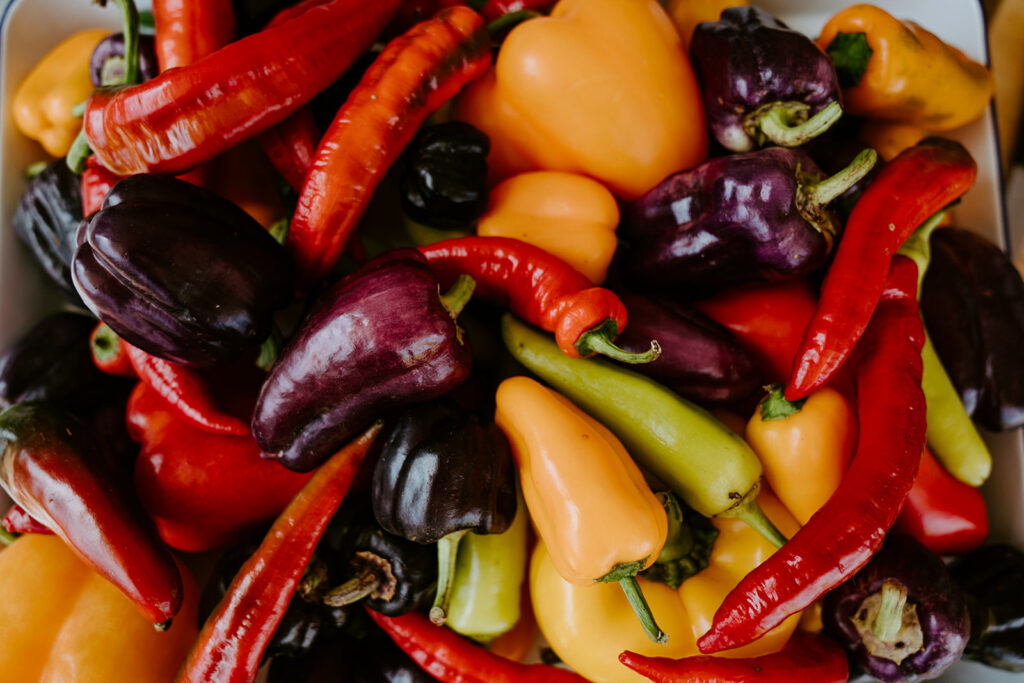
The modern pepper, known as capsicum in the UK, received its name from overly optimistic Spanish explorers on the hunt for lucrative black peppercorn plants. Related to other nightshades such as potatoes, tomatoes, and eggplant, the pepper family features a great diversity of flavors, colors, and shapes, as well as a host of nutritional and medicinal benefits.
SEASONAL IN SOUTHERN CALIFORNIA
PLANT: April through June
HARVEST: July through October
HISTORY
Peppers have been cultivated for more than 9000 years, starting in the kitchen gardens of South and Central American civilizations. Mistaken (perhaps wilfully) by Spanish explorers for the coveted black peppercorn, the pepper plant was spread throughout the Americas and West Indies by traders and colonists, leading to the development of countless regional breeds. By the late 19th century, mild bell peppers were a fairly common ingredient in the United States, with early cookbooks listing recipes for both stuffed and pickled peppers
NUTRITION
All pepper varieties are excellent sources of vitamins A and C, as well as potassium, folic acid, and many antioxidants and carotenoids. Spicy peppers have been linked to lowering blood pressure, cholesterol, and inflammation.
STORAGE
Wrap unwashed peppers in a lightly dampened paper towel, seal in a plastic bag, and store in the refrigerator crisper for up to 5 days. Green peppers will last slightly longer than red or orange varieties.
PREPARATION
Hollowed out peppers make ideal vessels for stuffing with grain, meat or other fillings, to be served cold or baked. Spicy peppers can be turned into relish or jelly, pounded into a paste, or steeped in oil. Sweet peppers can be sautéed or roasted over an open flame, and served with egg dishes, stir-fry, grilled meat, pizza, and pasta, or added to tomato soup for a more complex acidic flavor. Traditional dishes with peppers include Mexican fajitas, French ratatouille, Italian peperonata, and Greek gemista.
COOKING
Cut bell peppers in half and remove seeds. Roast peppers over an open flame until blistered all over, then enclose in a sealed container while still hot. When peppers are soft, combine in a blender with walnuts, fresh garlic, cumin, paprika, olive oil, and a splash of balsamic vinegar. Blend until smooth, then season with salt to taste. Serve as a dip with crusty bread, topped with crumbled goat cheese if desired.
PRO TIPS
Anecdotal evidence suggests that bell peppers with four “bumps” at the base will be sweet, while those with three bumps are more bitter.
Radish
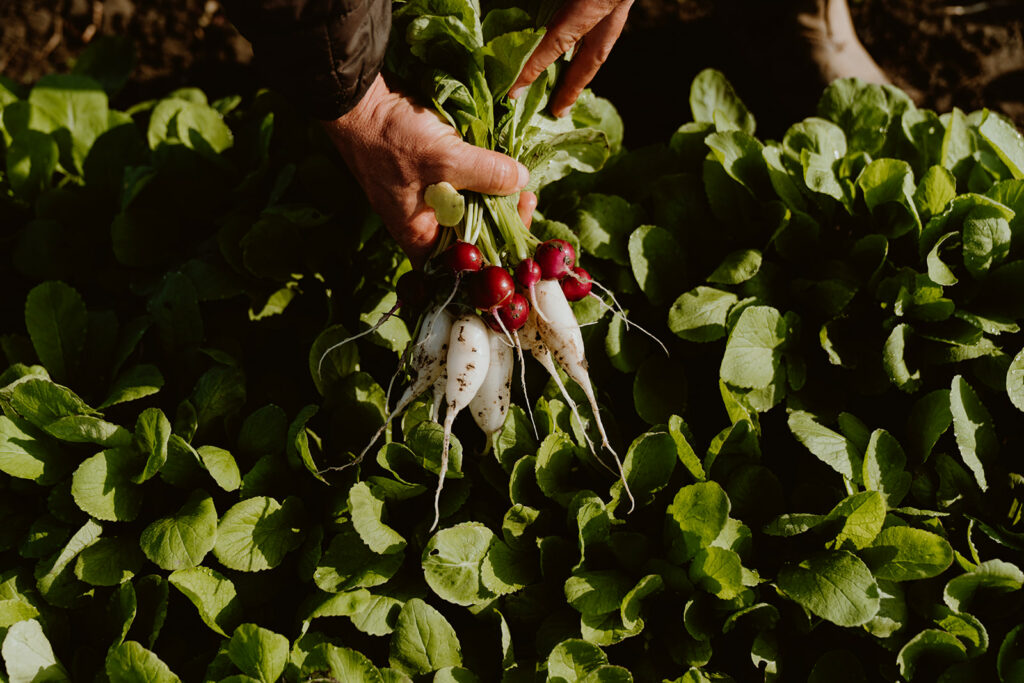
This spicy-sweet brassica boasts a surprising range, with a wide spectrum of shapes, colors, flavors, and growing seasons. It plays a role in traditional food cultures around the world, from Japan to Mexico to France.
SEASONAL IN SOUTHERN CALIFORNIA
PLANT: January through December
HARVEST: January through December
HISTORY
The radish is believed to have been domesticated in Central Asia around the 3rd century BC and spread quickly to Europe and later the Americas. It has played a role in food cultures throughout time, from the Egyptian laborers who built the pyramids being paid in radishes, to the people of Oaxaca, Mexico who still celebrate a holiday known as Night of the Radishes.
NUTRITION
Radishes are a rich source of vitamins C and B6, potassium and calcium, as well as trace minerals such as magnesium and copper.
STORAGE
Snip off leaves about ¼ inch from the top of the radish, clean off any soil, wrap in a cloth or paper towel, and store in an unsealed bag or container in the refrigerator crisper for up to 2 weeks.
PREPARATION
The raw radish can be julienned or shaved as a topping for tacos, added to slaws, or fermented with rice vinegar and soy for an Asian pickle. Radishes can be roasted, braised, or even halved and added to the grill—the smoky char adds a wonderful dimension to their spicy flavor. Radish leaves add a kick to any salad or sauteed greens.
COOKING
Thinly slice or shave radishes, and toss with a mixture of shredded cabbage and cilantro. Add lime juice, olive oil, and salt, and allow to marinate. Serve alongside enchiladas or barbacoa, or add avocado chunks and toasted pepitas for a delicious salad.
PRO TIPS
Most of the radish’s spicy flavor is concentrated in the skin. Leave on to enjoy the tangy kick, or for a mellower flavor, simply peel before cooking or eating. Larger radishes can sometimes have a bitter flavor—remove by salting and letting them sit for a while before serving.
Sage
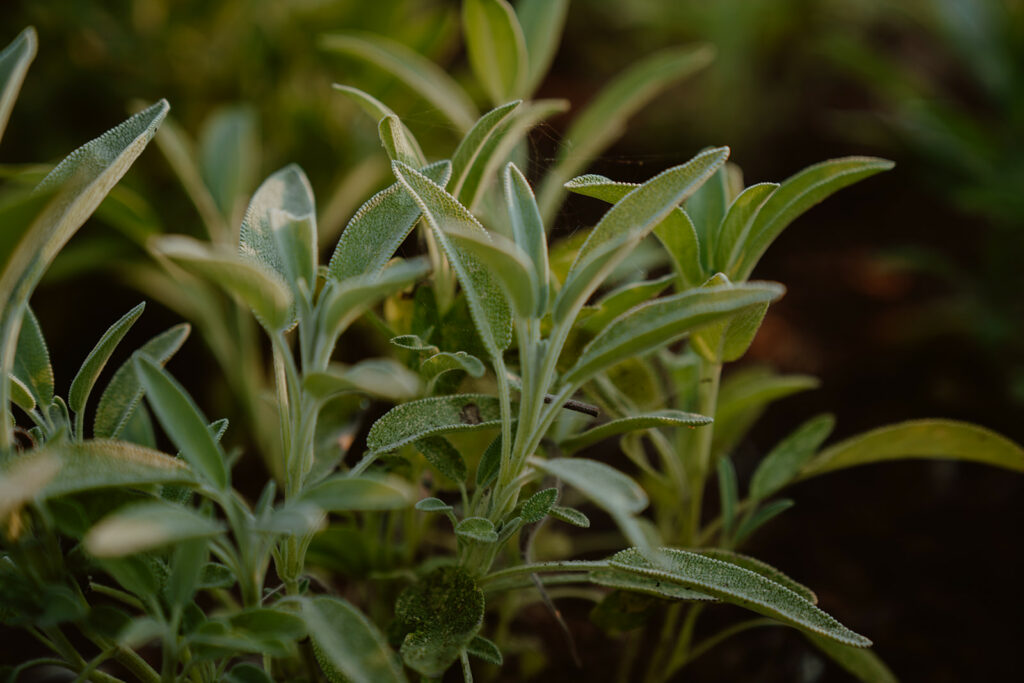
Native to the Mediterranean coast, common sage is named for from the Latin word meaning “to be saved,” thanks to its reputation as a medicinal cure-all.
SEASONAL IN SOUTHERN CALIFORNIA
PLANT: January through May
HARVEST: January through December
HISTORY
Ancient Egyptians used sage to stimulate fertility and to treat infectious diseases; it was also the main ingredient used in embalming. The Greeks and Romans used sage medicinally to enhance memory, while in the kitchen it was used as a meat preservative. The ancient Chinese eagerly adopted the use of sage and traded four pounds of tea for every one pound of sage. Today, there are over 700 species of sage spread throughout the world.
NUTRITION
Sage is high in vitamins A, C, E, and K and is a good source of folate, calcium, iron, magnesium, and manganese. It has shown promise in treating Alzheimer’s disease, cardiovascular disease, depression, and menopause symptoms. Its antiseptic properties can also help heal a sore throat, canker sores, gum disease, and fungal infections.
STORAGE
Wrap sage sprigs in a damp paper towel, seal in a plastic bag or jar and keep in the refrigerator crisper for up to 5 days. Alternatively, cover leaves with olive oil and store them in the refrigerator for about 3 weeks.
PREPARATION
With a dusky, dry flavor that complements meat and poultry, sage is a regular addition to traditional stuffing, as well as classic soup, stew, and sauce recipes. Sage leaves fried in butter are a delicious garnish for seafood and pasta.
PRO TIPS
If not using a whole sprig of sage, separate leaves from the stem and chop finely to use. 1 tablespoon of fresh sage substitutes for 1 teaspoon dried.
Shelling Beans
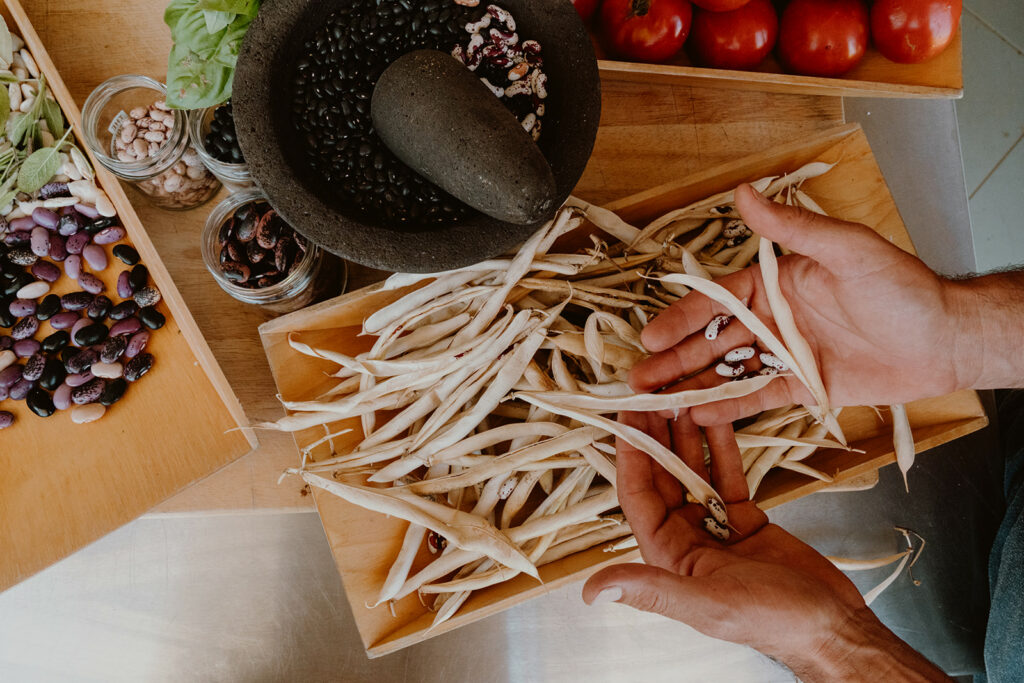
Beloved for its juicy sweetness and high nutrition content, spinach is the rare green that doesn’t feature any bitter taste.
SEASONAL IN SOUTHERN CALIFORNIA
PLANT: October through June
HARVEST: October through June
HISTORY
Spinach is believed to have originated about 2000 years ago in ancient Persia. It was introduced to China in the 7th century as a gift from the king of Nepal, and spread from there to India and the Middle East. Two hundred years later, Middle Eastern explorers introduced spinach to Europe. Its popularity skyrocketed during the Renaissance, thanks to Catherine de Medici, queen of Florence’s ruling family. Thanks to her love for spinach, dishes that include the vegetable are frequently said to be prepared “à la Florentine.”
NUTRITION
Spinach is legendary for being extremely nutrient-rich. Its dense mineral profile includes iron, potassium, magnesium, and calcium, and it has high concentration of vitamins B6, B9, C, E and K.
STORAGE
Thoroughly rinse spinach leaves and spread to dry on a towel (or spin in a salad spinner). When very dry, pack loosely in a plastic bag with a paper towel inside to absorb moisture. Spinach will stay fresh up to a week, but make sure to check every few days to remove any wilting or rotten leaves.
PREPARATION
Spinach’s natural sweetness makes it an easy addition to just about any recipe. Toss a handful of torn spinach leaves into soups, stews, pasta sauces, even smoothies or juices for an extra kick of nutrition. Cooked spinach can be added to egg dishes, grain bowls, bean dishes, or dips, or stuffed into meat or fish.
COOKING
Fry chopped garlic cloves in olive oil, then stir in a heaping spoonful of smoked Spanish paprika. Add several handfuls of fresh spinach leaves and a small amount of water, and cook until water is absorbed and spinach is wilted. Add a handful or two of cooked chickpeas, season with salt and additional paprika, and stir until heated through. Serve with more olive oil and crusty bread.
PRO TIPS
No need to remove spinach stems—they are tender and soften easily when cooking. They are also good for your health, with an extra dose of vitamins and minerals.
Spinach
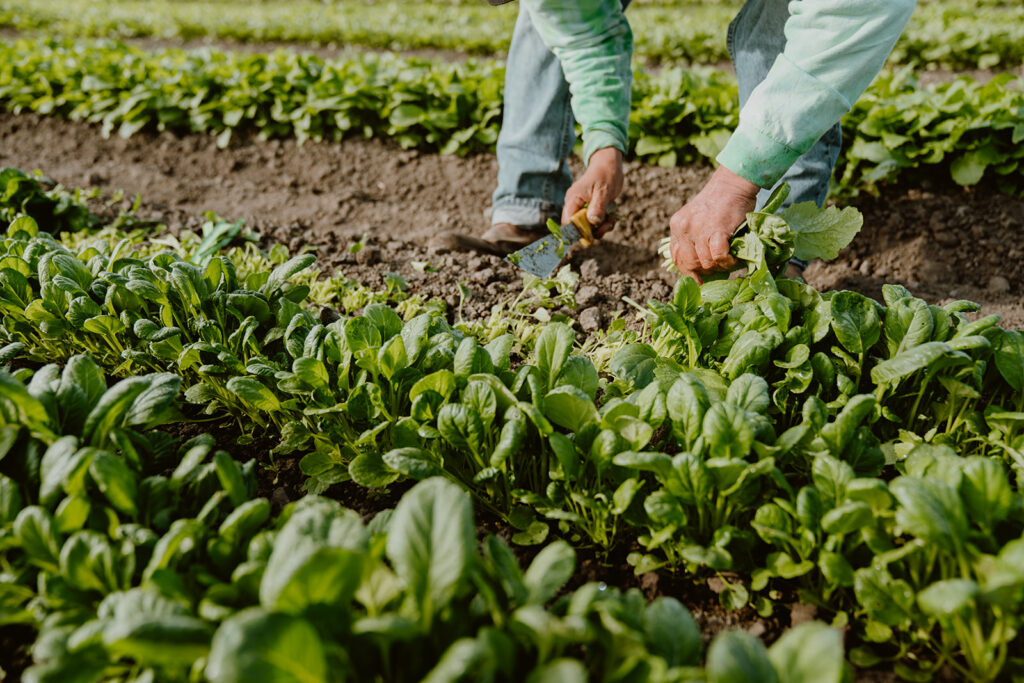
Beloved for its juicy sweetness and high nutrition content, spinach is the rare green that doesn’t feature any bitter taste.
SEASONAL IN SOUTHERN CALIFORNIA
PLANT: October through June
HARVEST: October through June
HISTORY
Spinach is believed to have originated about 2000 years ago in ancient Persia. It was introduced to China in the 7th century as a gift from the king of Nepal, and spread from there to India and the Middle East. Two hundred years later, Middle Eastern explorers introduced spinach to Europe. Its popularity skyrocketed during the Renaissance, thanks to Catherine de Medici, queen of Florence’s ruling family. Thanks to her love for spinach, dishes that include the vegetable are frequently said to be prepared “à la Florentine.”
NUTRITION
Spinach is legendary for being extremely nutrient-rich. Its dense mineral profile includes iron, potassium, magnesium, and calcium, and it has high concentration of vitamins B6, B9, C, E and K.
STORAGE
Thoroughly rinse spinach leaves and spread to dry on a towel (or spin in a salad spinner). When very dry, pack loosely in a plastic bag with a paper towel inside to absorb moisture. Spinach will stay fresh up to a week, but make sure to check every few days to remove any wilting or rotten leaves.
PREPARATION
Spinach’s natural sweetness makes it an easy addition to just about any recipe. Toss a handful of torn spinach leaves into soups, stews, pasta sauces, even smoothies or juices for an extra kick of nutrition. Cooked spinach can be added to egg dishes, grain bowls, bean dishes, or dips, or stuffed into meat or fish.
COOKING
Fry chopped garlic cloves in olive oil, then stir in a heaping spoonful of smoked Spanish paprika. Add several handfuls of fresh spinach leaves and a small amount of water, and cook until water is absorbed and spinach is wilted. Add a handful or two of cooked chickpeas, season with salt and additional paprika, and stir until heated through. Serve with more olive oil and crusty bread.
PRO TIPS
No need to remove spinach stems—they are tender and soften easily when cooking. They are also good for your health, with an extra dose of vitamins and minerals.
Strawberry
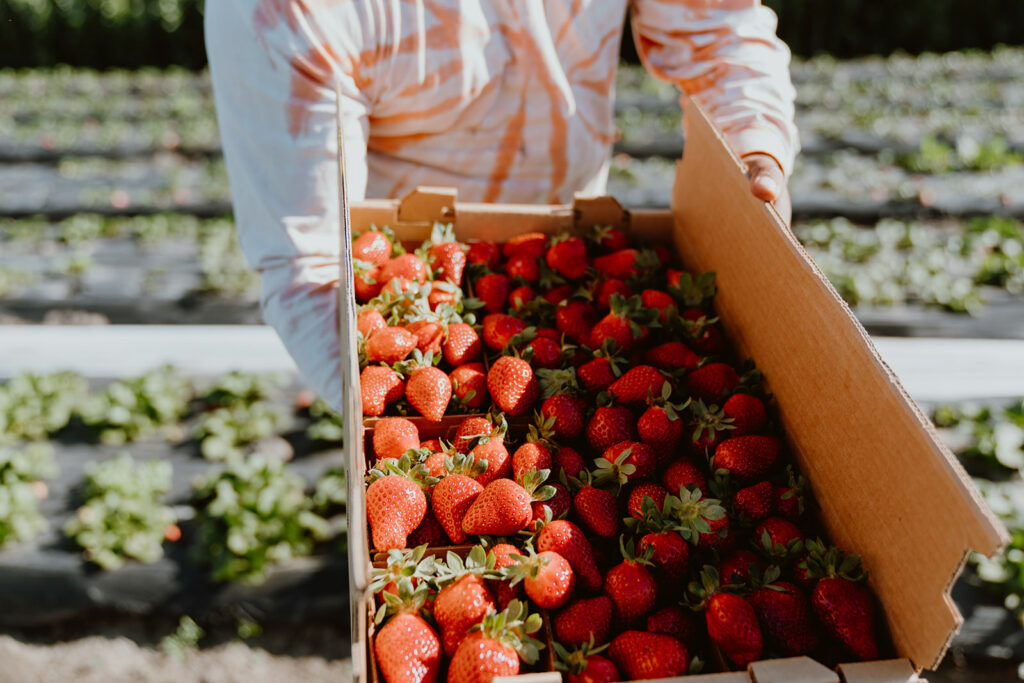
Possibly the world’s most popular berry, strawberries are an unmistakable sign that spring has arrived. While many mass-produced strawberry varieties are bred for texture and size over taste, organically grown strawberries preserve the delicate wild sweetness that makes these springtime treats legendary.
SEASONAL IN SOUTHERN CALIFORNIA
PLANT: January through March
HARVEST: April through July
HISTORY
Humans have enjoyed wild strawberries for millennia but did not begin cultivating them until relatively recently. Around the 14th century, it was common practice to forage wild strawberry plants from the forest and replant in a kitchen garden—one French king collected 1,200 wild plants for his royal garden. By the 17th century, several European subspecies had been crossed, and with the addition of a female-flowering species brought back from South America, the modern strawberry was born. The first fully domesticated strawberry was farmed in northern France at the end of the 18th century.
NUTRITION
The ancient Romans consumed wild strawberries (the leaves and stems as well as the fruits) to cure depression; crushed strawberries mixed with salt were also a folk remedy to heal blisters and wounds. In the 18th century Europe, strawberries were considered to heal kidney stones, gout, and even summer colds; today’s science bears this out, with evidence supporting the ability of strawberries to help reduce cholesterol, blood pressure, and inflammation, and prevent blood sugar and insulin spikes.
STORAGE
In general, it’s best to leave berries unwashed until just before using. That said, if you plan to save the strawberries for more than a couple of days, it can help to wash them in a vinegar bath to kill any spores on the fruit. Submerge strawberries in a cold bath of 1 part white vinegar to 8 parts water, leave for no more than 5 minutes, then spread out between two towels, and let air-dry completely before returning to the refrigerator.
PREPARATION
Before using in a recipe, pick through strawberries and remove any that have gone extra soft (unless you plan to puree them in a soup or sauce). Rinse strawberries in cold water, then remove the hulls with the end of a knife or by simply pinching off the green stem with your fingers.
COOKING
Strawberry desserts are found in cultural foodways across the globe, from English/American strawberry shortcake and Swedish Midsummer cake to Mexican fresas con crema and Chinese tanghulu. But strawberries offer a sweet overtone to a variety of savory dishes, pairing well with ingredients like pork, fennel, spinach, spicy peppers, feta or goat cheese, and fresh herbs like basil, tarragon or sage. Try adding strawberries to salsa, gazpacho, or teriyaki sauce, or simmering with peppercorns in red wine or balsamic vinegar for an all-purpose seasonal condiment to use over meat. Combine halved strawberries with torn basil and slices of Brie for a new take on the Caprese salad, or layer with Prosciutto, ricotta and fines herbs on toasted bread for a sweet-savory crostini.
PRO TIPS
To freeze fresh strawberries, rinse, hull, and slice strawberries in half. (Smaller berries can be left whole.) Place strawberries on a baking sheet lined with parchment paper, ensuring the berries do not touch each other. Place the baking sheet of strawberries in your freezer for 2 to 3 hours, removing when partially frozen. Transfer to a resealable bag, press out as much air as possible, and return bag to the freezer. Frozen strawberries will keep for up to 1 year.
Summer Squash
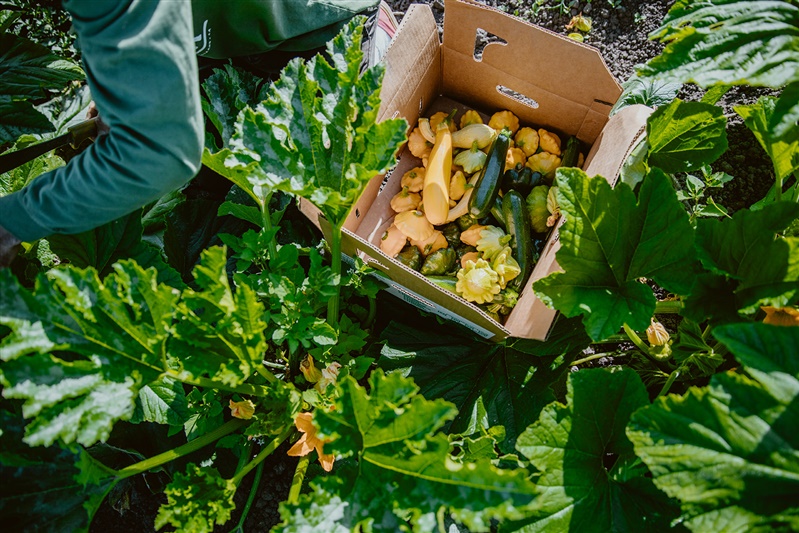
Summer squash refers to a squash harvested before it is fully mature, while the rind is still thin and soft. The name refers not to when they are harvested, but to their shorter storage life compared to winter squash.
SEASONAL IN SOUTHERN CALIFORNIA
PLANT: February through September
HARVEST: May through October
HISTORY
Historians believe that squash is North America’s oldest cultivated food, predating even corn and beans, the other crops included in the traditional “Three Sisters” companion growing method. A mainstay of the indigenous North American diet, the squash, along with its blossoms and seeds, were eaten at all levels of ripeness, and even dried in strips for long journeys. Explorers’ logs from the 17th to the 19th centuries make mention of squash being eaten by indigenous people from the northeast to the western edge of the Great Plains. Summer squashes were brought to Europe as early as 1590, and were readily adopted by colonial American farmers as well.
NUTRITION
Summer squash is a good source of vitamins A, B6, C and K, phosphorus, folate, magnesium, and potassium.
STORAGE
Gently wipe any dirt from summer squash, then store in an unsealed or perforated plastic bag in refrigerator crisper for up to 4 days.
PREPARATION
Summer squash has a firm yet tender texture and a mild, cucumber-like flavor that adapt well to all kinds of preparation. Raw summer squash can be sliced thinly and marinated as a vegetarian carpaccio, or spiralized into noodles and eaten like cold pasta. Summer squash pairs beautifully with other summer vegetables such as tomatoes and eggplant in sautés, terrines, and stews, as well as baking with a savory filling or grilling. A favorite preparation is shredding squash and combining with onions, eggs and flour as fritters, or coating in batter and frying into tempura.
COOKING
Cut summer squash into small chunks and toss with kosher salt; place in colander and allow to drain for at least 30 minutes. Pat dry, then add in a single layer to a hot, oiled frying pan. Brown for at least 5 minutes, then reduce heat, cover pan, and let cook until tender. Remove and toss with additional olive oil, garlic, vinegar, sugar, red pepper flakes, and chopped herbs. Let marinate for at least another 15 minutes. Serve over crusty bread spread with ricotta cheese, topped with toasted pine nuts.
PRO TIPS
A common complaint is that summer squash ends up too watery when cooked. There are two solutions. First, salt the squash and let drain for at least 30 minutes before using. Second, cut squash into larger pieces before cooking.
Tarragon
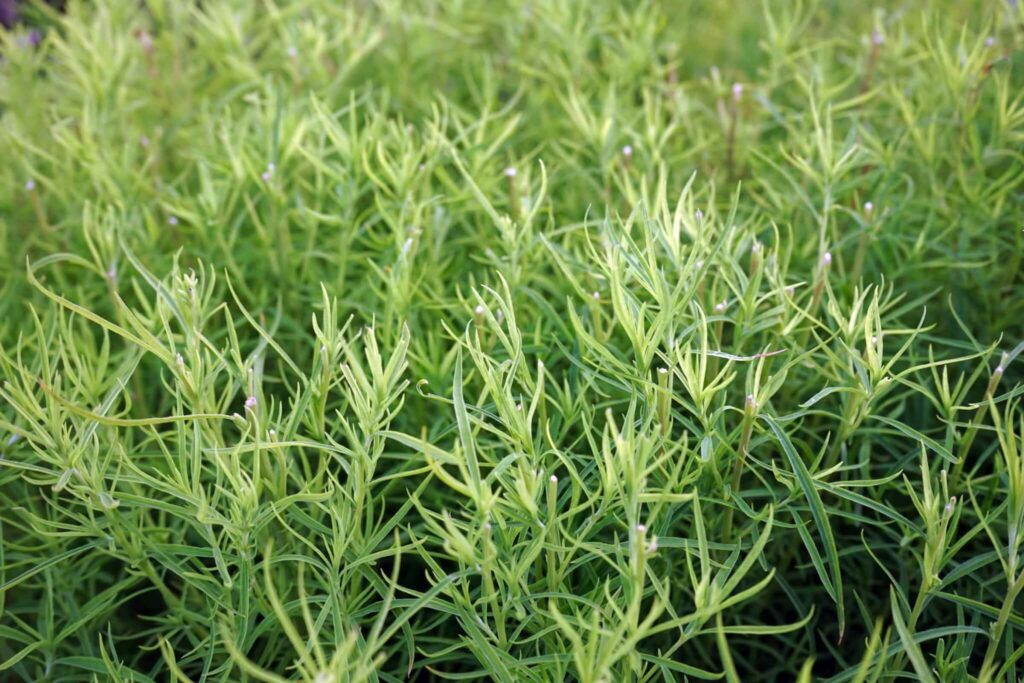
Tarragon is a perennial herb native to Siberia, with a strong anise-like flavor (their oils are chemically identical). Its name is derived from a Latin word meaning “little dragon,” thanks to its twisting roots, and it was traditionally believed to cure dragon bites as well as insomnia and bad breath.
SEASONAL IN SOUTHERN CALIFORNIA
PLANT: January through May
HARVEST: January through December
HISTORY
Tarragon is a fairly “young” herb, having only been cultivated for around 600 years. It is believed that invading Mongols brought tarragon to Italy sometime in the 10th century. In the 14th century, St. Catherine carried tarragon with her on a pilgrimage to France, where it is principally used today. celebrate a holiday known as Night of the Radishes.
NUTRITION
Tarragon is a good source of vitamins A, B6, and C, as well as folate, calcium, iron, magnesium, potassium, and manganese. Tarragon has been traditionally used to treat poor digestion, intestinal problems, rheumatism, gout, arthritis, and toothache.
STORAGE
Wrap tarragon sprigs in a damp paper towel, seal in a plastic bag or jar and keep in the refrigerator crisper for up to 3 weeks.
PREPARATION
Tarragon is a key herb in French cooking and is included with chervil, chives, and parsley under the term fines herbs.It is the main flavoring in béarnaise sauce, features in a number of Eastern European recipes, and is a principal herb in Persian-style pickles. Tarragon goes well with poultry, fish, and egg dishes, and is complemented by acidic flavors in citrus and vinegar, making it a popular addition to salad dressings and marinades.
PRO TIPS
If not using a whole sprig of tarragon, separate leaves from the stem and chop finely to use. 1 tablespoon of fresh tarragon substitutes for 1 teaspoon dried.
Thyme
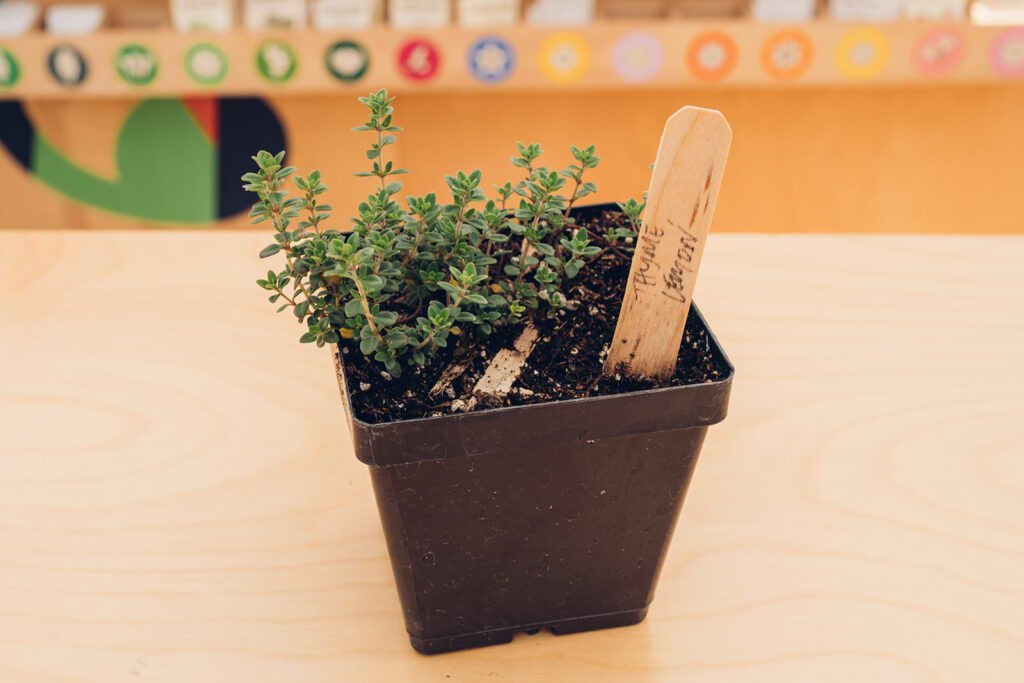
A member of the mint family with small curling leaves, thyme is native to the southern Mediterranean region. Its antimicrobial properties have led to its long use as a food preservative, as well as a healing and purifying medicinal herb.
SEASONAL IN SOUTHERN CALIFORNIA
PLANT: January through May
HARVEST: January through December
HISTORY
Thyme was used as an embalming ingredient by the ancient Egyptians, and bundles of thyme were traditionally burned by ancient Greeks and Romans to purify both homes and temples. The Romans also ate thyme sprigs before and after a meal, believing it to be an antidote to poison. This tradition continued with medicinal potions made from thyme used to combat the Black Death in the 1340s. Even in the 19th century, nurses soaked bandages in thyme-infused water. Throughout history, thyme was also used in baking, cooking and food preservation to help protect against spoilage and foodborne disease.
NUTRITION
Along with nutrients such as vitamins A and C, potassium, and magnesium, thyme is known for containing a powerful antiseptic known as thymol, a common ingredient in mouthwash, hand sanitizer and acne medication.
STORAGE
Stand thyme sprigs in a jar with 1 to 2 inches of water, and keep for up to 3 weeks. Alternatively, wrap thyme sprigs in a damp paper towel, seal in a plastic bag or jar, and keep in the refrigerator crisper for up to 1 week.
PREPARATION
With its deep, pungent flavor, thyme is part of the traditional French bouquet garni used to flavor stock and soups, as well as the Middle Eastern spice mix za’atar. Another popular use of thyme is infusing it into oil or butter and using to baste meat, poultry or fish while roasting or grilling. It offers warm, earthy flavor to grains and legumes, as well as marinades and vinaigrettes, and is a tasty addition when sprinkled onto garlic bread. It also pairs well with sweet flavors, and can be infused into jellies or syrups for use in dessert or cocktails.
PRO TIPS
If not using a whole sprig of thyme, separate leaves from stem and chop finely to use. 1 tablespoon of fresh thyme substitutes for 1 teaspoon dried.
Tomato
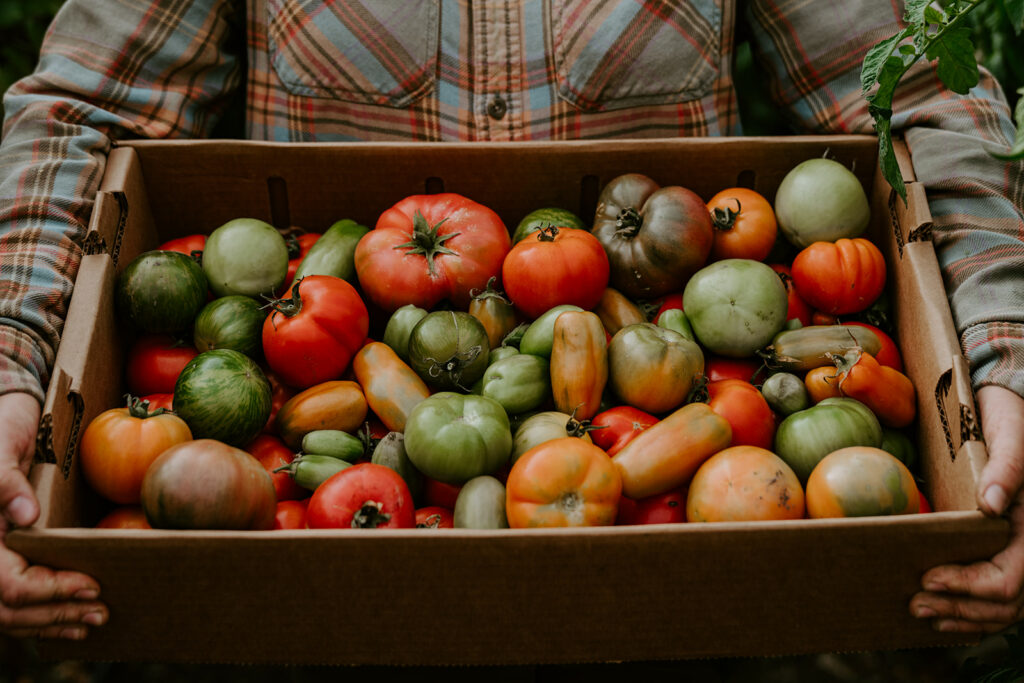
The crown jewel in any summer garden, the tomato boasts a flavor that is both instantly recognizable and mysteriously indefinable. Each heirloom variety boasts a signature proportion of sweet, acidic and earthy flavors, as well as its own color, size, shape, and texture.
SEASONAL IN SOUTHERN CALIFORNIA
PLANT: February through August
HARVEST: July through October
HISTORY
Cultivated since 700 A.D. in the coastal highlands of Mexico and Central and South America, tomato seeds were carried back to Europe in the 1500s and quickly spread throughout the continent. The “heirloom” distinction refers to seeds that have been in existence at least 50 years.
NUTRITION
Tomatoes are an excellent source of vitamins A and C, and a good source of vitamin K and potassium. Heirloom tomatoes are particularly high in lycopene, a carotenoid that helps prevent cancer.
STORAGE
Heirloom tomatoes typically have a high juice content and a thin skin, making them delicious but also delicate. Avoid refrigeration; instead, store in a single layer at room temperature, out of direct sunlight, until ready to eat. Large varieties should be stored stem-down to minimize softening at the base; cherry tomatoes can be stored together in a basket.
PREPARATION
A perfectly ripe summer tomato needs nothing more than a sprinkle of salt to bring out its amazing flavors. They are also natural pairings with fresh or cooked salads, sandwiches, and dips such as hummus or guacamole.
COOKING
Fill a basic pie shell with a mix of your favorite roasted summer vegetables, then top with thick slices of heirloom tomato (or halved cherry tomatoes). Bake until crust is set and the edges of the tomatoes are charred. Serve room temperature or cold, with a sprinkle of fresh herbs, a drizzle of olive oil and a dusting of flaky salt.
PRO TIPS
Since heirloom varieties tend to have a shorter shelf life, make sure to consume them within 5 days or less.
Winter Squash
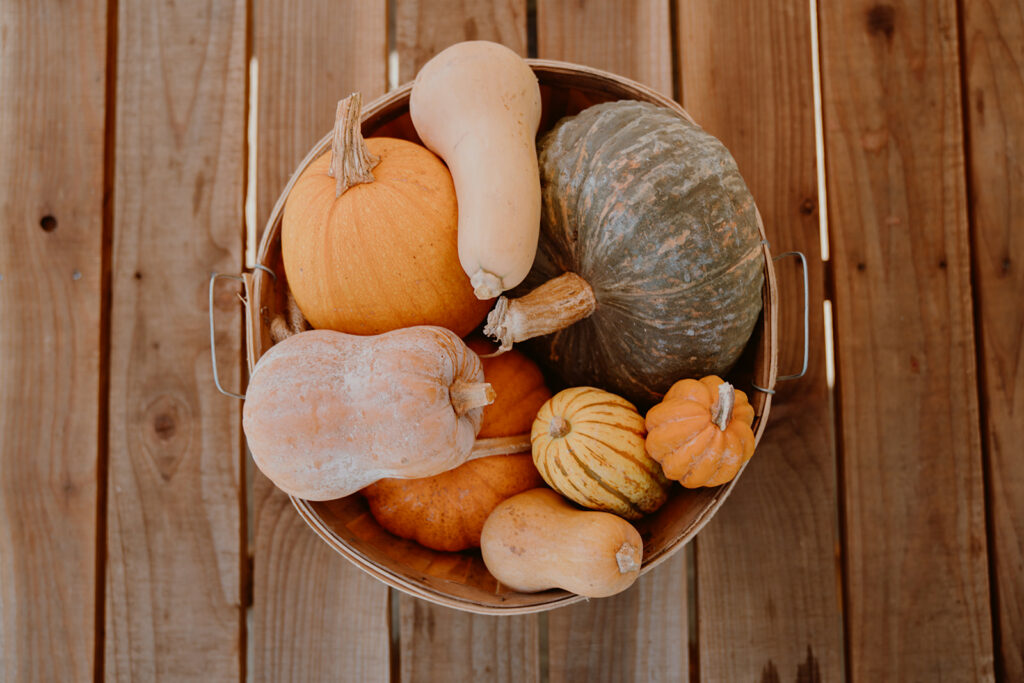
This hard-shelled vining fruit is a mainstay of indigenous American foodways. Beloved today for its sweet taste, soft texture and filling nutrition, winter squash was traditionally consumed in its entirety, with flesh and seeds roasted for food, and shells dried out for use as containers and water vessels.
SEASONAL IN SOUTHERN CALIFORNIA
PLANT: July through May
HARVEST: October through June
HISTORY
Native to Mexico and Central America, winter squash were used to pioneer the method of “companion planting,” in which crops were planted in pairs to contribute to each other’s growth. In the American southwest, winter squash, corn and beans were known as the Three Sisters, and planted in a system known as the milpa. Carried across the Atlantic by European invaders, winter squash was embraced by people around the Mediterranean Basin, and eventually carried to Asia by Portuguese traders in the 16th century.
NUTRITION
supplied beta carotene, Omega 3’s and Potassium
STORAGE
Unpeeled, uncut winter squash can be kept for up to 3 months in a cool, dark, well-ventilated location. Cut and peeled squash can be kept in a sealed plastic bags in the refrigerator crisper for up to 5 days.
PREPARATION
Winter squash is one of the easiest vegetables to prepare: simply slice in half, remove seeds, and roast at high heat until flesh is soft enough to scrape out of the skin. Squash can also be peeled and cubed before being cooked. Starchy varieties like kabocha and kuri are best for frying and baking, while dense varieties such as pumpkin and acorn squash are better for baking or steaming, and the softer butternut and delicata are ideal for purées, soups, stews and curries.
COOKING
Cut winter squash down the middle, remove seeds, and roast at 450 for about 60 minutes, or until squash can be easily pierced with a fork. Let cool slightly and scoop flesh out of skin. Add cooked squash to a high-speed blender with sautéed onions and garlic, a whole apple (seeds removed), and enough vegetable broth to barely cover. Add your favorite spices such as curry and garam masala, cumin and chile, or cinnamon, nutmeg and pepper. Add a dash of cream or coconut milk, if desired. Process in a blender until mixture is thick and smooth. Add salt and pepper to taste, and serve topped with roasted squash seeds.
PRO TIPS
Winter squash seeds can be easily removed using a melon baller or ice cream scoop in place of a spoon.


